Early Views of Wilshire and Fairfax
Historical Photos of Wilshire and Fairfax |
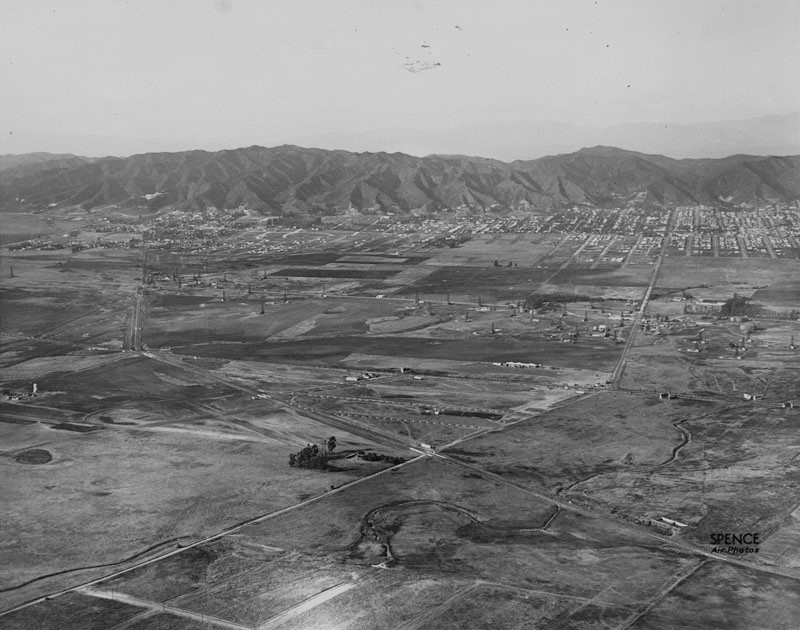 |
|
| (1922)^ - Aerial view looking northwesterly showing Crescent Ave (later Fairfax Ave) running diagonally from lower-left to center-right where it crosses Wilshire Boulevard (center-right) and makes a slight bend north towards the Hollywood Hills. San Vicente runs diagonally from lower-right to upper left and turns up toward West Hollywood. Note the oil wells scattered across the open land. |
Historical Notes In the early 1920s, the stretch of Wilshire Boulevard now known as the Miracle Mile was a 20-foot-wide dirt road, flanked by oil wells and barley fields. Today, the strip is a busy thoroughfare, home to museums, the La Brea Tar Pits, and a collection of historic Art Deco structures. |
Wilshire and Fairfax
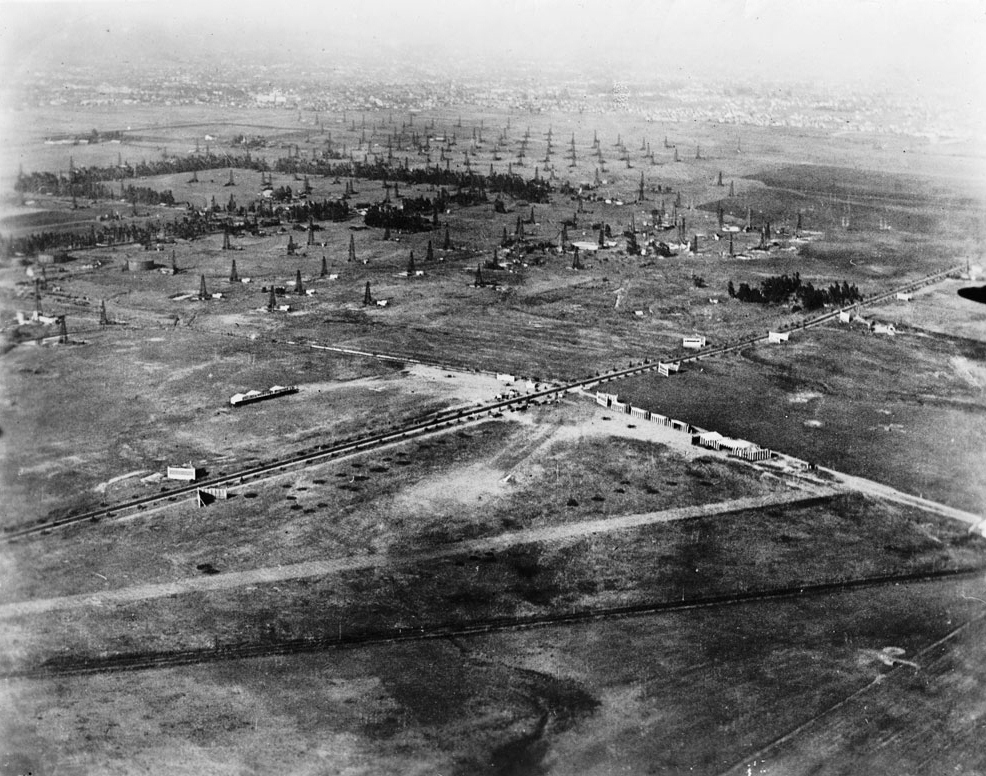 |
|
| (1920)* - Aerial view of Crescent Avenue (now Fairfax) and Wilshire Boulevard in 1920 showing undeveloped land with many oil derricks. In the lower part of the photograph is Chaplin Airport. The tree-lined street is Wilshire. The diagonal line at the bottom is actually railroad tracks that would later become San Vicente Bouelvard. |
Historical Notes The Fairfax District was little more than bean fields at the turn of the century when Arthur Fremont Gilmore set out to dig a well on his 256-acre dairy farm near West 3rd Street in Fairfax Avenue. But instead of water, Gilmore struck oil. His discovery is credited with prompting an oil exploration boom in the area- later called the Salt Lake oil fields. Gilmore helped build the Fairfax area into one of the city’s best-known commercial areas (Farmers Market). |
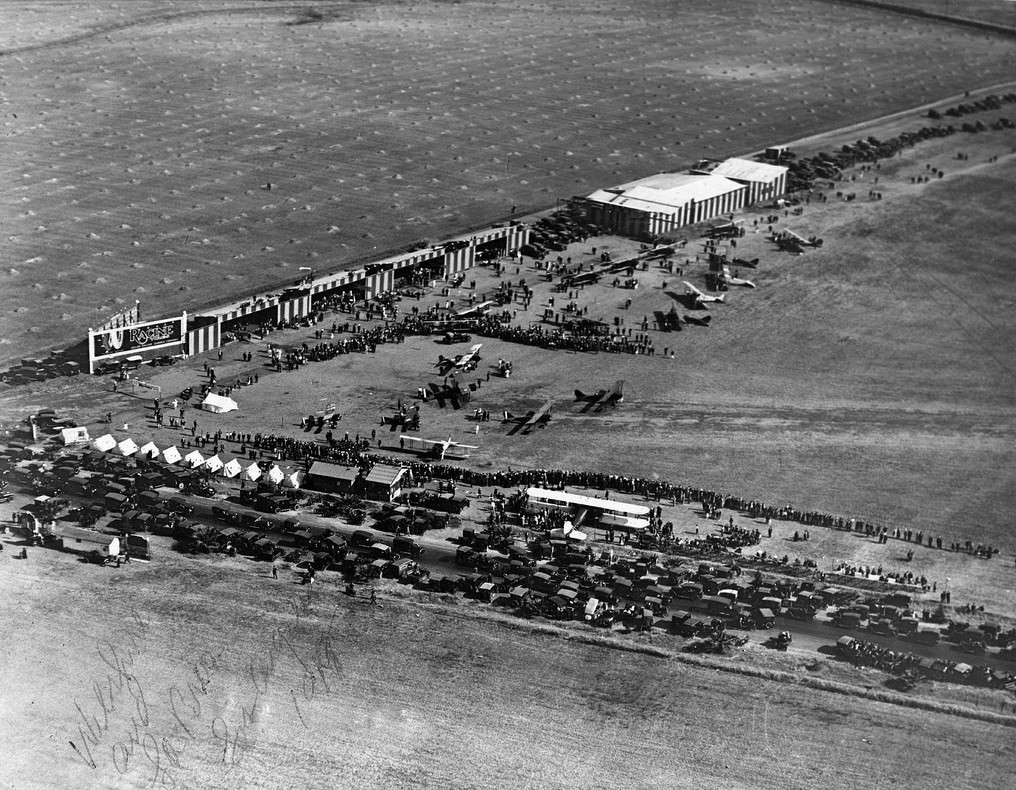 |
|
| (1920)* - Aerial view looking southeast showing crowds of people at Sid Chaplin's airport at the southwest corner of Wilshire Boulevard and Crescent Avenue (now Fairfax Avenue). Dozens of cars are parked in rows in the foreground, with several airplanes parked behind them in the more open field. A vendor tent is visible farther up the image, near more parked cars. A billboard to the left reads "Racine Tires". |
Historical Notes Chaplin Airfield was located on leased property that is now bounded by Wilshire Boulevard, Fairfax Avenue, and San Vincente Boulevard. The Syd Chaplin Aircraft Corporation advertised that it “maintained a fleet of newest Curtis one and two-passenger aeroplanes, large shops with complete equipment and hangars for our own ships as well as those belonging to business firms and individuals.” Syd Chaplin was the brother of famed actor Charlie Chaplin. |
 |
|
| (2023)* – A Google Earth view looking down at the area southwest of Wilshire and Fairfax, where Sid Chaplin's airport once stood. Photo comparison by Jack Feldman. |
Then and Now
 |
|
| (1920 vs. 2023)* - A 'Then and Now' aerial photo comparison showing the origianl Chaplin Airfield and how it has evolved over a century. |
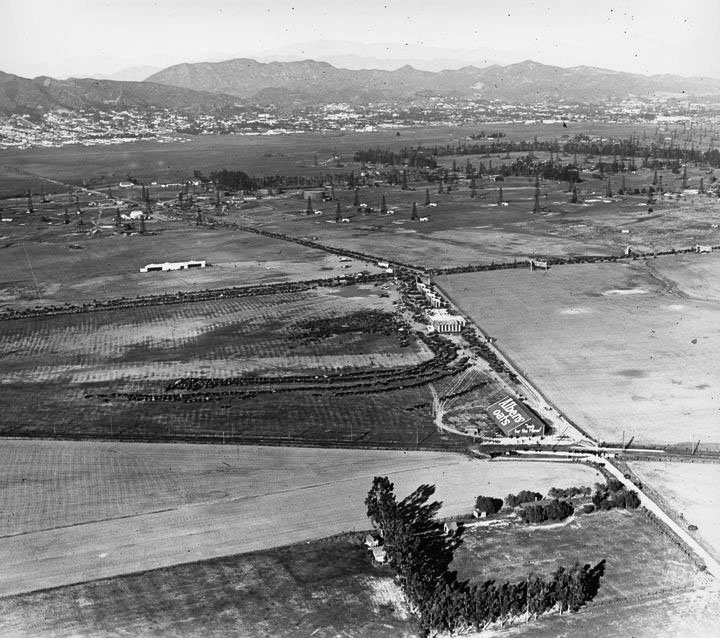 |
|
| (ca. 1922)* - View looking north shows numerous cars parked on a lot (center of photo) near the airfield as well as along Wilshire Blvd. and Crescent Ave (Fairfax). Large sign on building in the lower-right center at the intersection of Fairfax and the San Vicente line of the Pacific Electric Railway reads: Albers Oats. |
Historical Notes In the 1890s, dairy farmer Arthur F. Gilmore found oil on his land, probably in the vicinity of the La Brea Tar Pits. The field was named after the Salt Lake Oil Company, the first firm to arrive to drill in the area. The discovery well was spudded (started) in 1902. Development of the field was fast, as oil wells spread across the landscape, with drillers hoping to match the production boom taking place a few miles to the east at the Los Angeles City field. Peak production was in 1908. By 1912, there were 326 wells, 47 of which had already been abandoned, and by 1917 more than 450, which had by then produced more than 50 million barrels of oil. After this peak, production declined rapidly. Land values rose, corresponding to the fast growth of the adjacent city of Los Angeles, and the field was mostly idled in favor of housing and commercial development. The early wells were abandoned; many of their exact locations are not known, and are now covered with buildings and roads. |
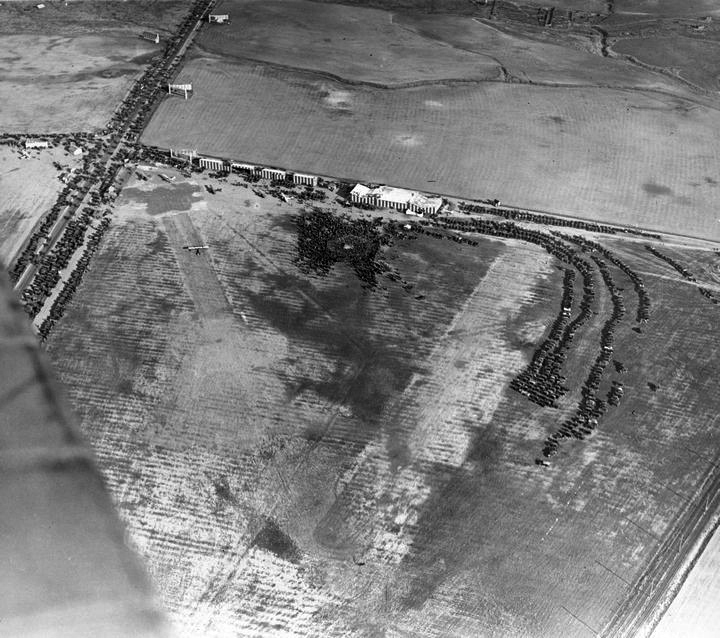 |
|
| (ca. 1922)^ – Aerial view looking down at the Chaplin Airdrome with the intersection of Crescent Avenue(later renamed Fairfax) and Wilshire Boulevard seen in upper-left. |
Historical Notes The Chaplin Aircraft Company offered observation flights for $10 and round-trip flights to San Diego for $150 (at a time when the average wage was $1,200 per/year). Obviously, the cost of air travel was very steep and Chaplin’s enterprise had a brief life span. Around 1922 Chaplin sold out to Emory H. Rogers, a business partner, who renamed it Rogers Field. |
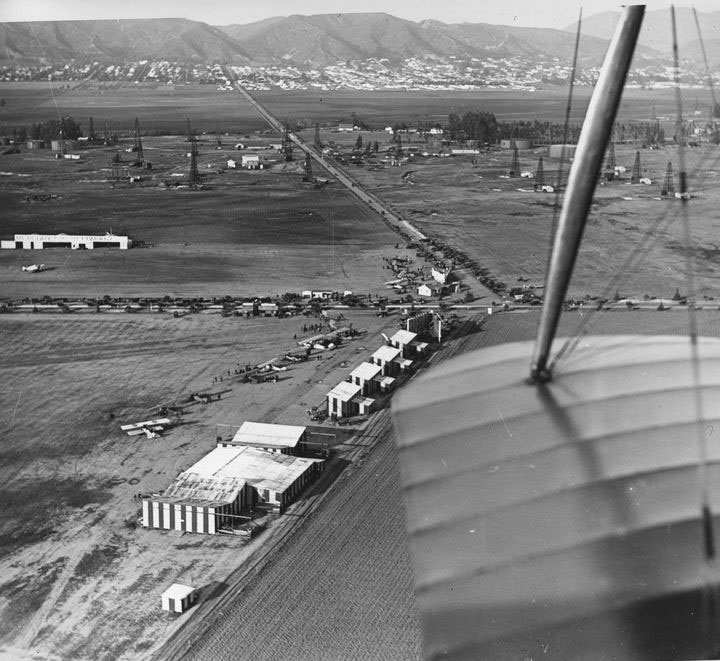 |
|
| (ca. 1922)* - View looking north over the wing of a bi-plane showing the intersection of Crescent Ave (Fairfax) and Wilshire Blvd. A crowded airfield (now Rogers Airfield) is seen below. In the distance oil derricks are seen at Fairfax Avenue where 6th Street is located today. In the far background, at the foothills, can be seen a built-up Hollywood. |
Historical Notes By 1922 both Chaplin Airfield (S/W corner) and De Mille Field No. 2 (N/W corner) would be owned by Emery H. Rogers, owner of Rogers Aircraft Inc. They would be part of Rogers Airfield which straddled Wislhire Boulevard west of Farifax Avenue. Click HERE to see more in Aviation in Early Los Angels. |
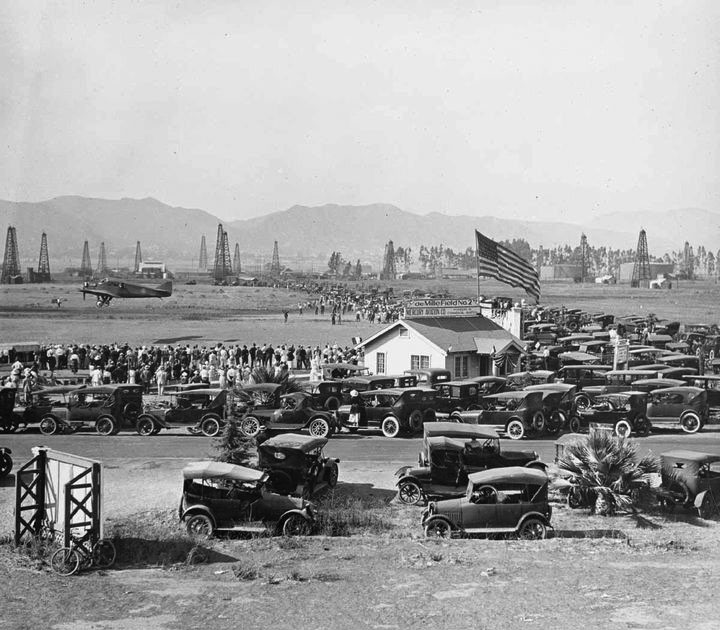 |
|
| (1920s)* - Parking lot is full as crowds attend air show at DeMille Field No. 2. The sign on top of the structure with the large American Flag reads: DeMille Field No. 2. View is looking northeast near the NW corner of Wilshire and Fairfax. In the background can be seen oil derricks and on the right (out of view) are the La Brea Tar Pits. |
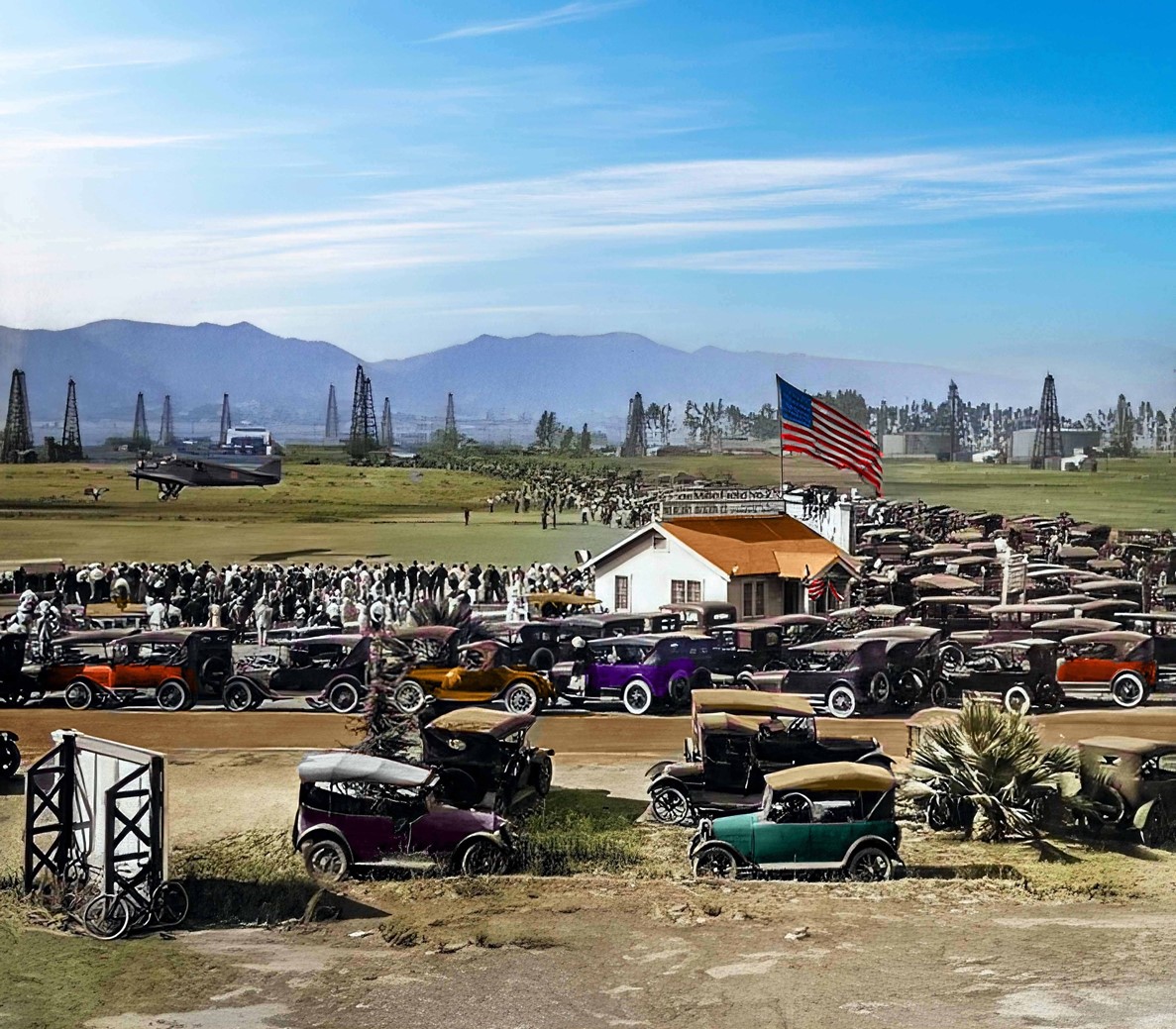 |
|
| (1920s)* - Parking lot is full as crowds attend air show at DeMille Field No. 2. The sign on top of the structure with the large American Flag reads: DeMille Field No. 2. View is looking northeast near the NW corner of Wilshire and Fairfax. In the background can be seen oil derricks and on the right (out of view) are the La Brea Tar Pits. Image enhancement and colorization by Richard Holoff |
 |
|
| (1924)* - View looking west on Wilshire Boulevard at Fairfax Avenue during the laying of new pavement. The Wilshire Fairfax Tract office is visible on the northwest corner. Photo courtesy of Peter Ferry. |
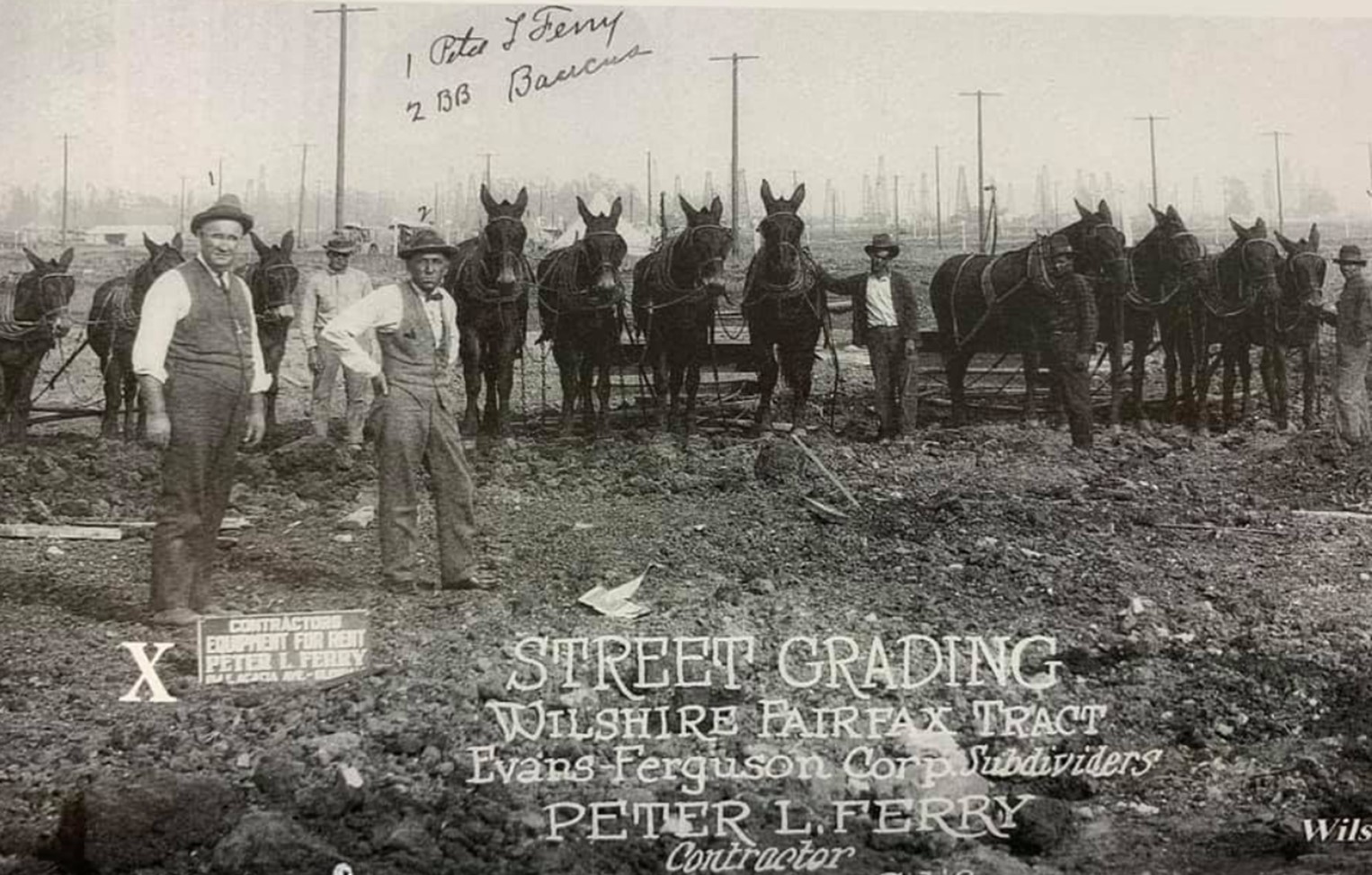 |
|
| (1924)* – Contractors Peter L. Ferry and B. B. Baucus pose in front of three teams of four-mule street graders during the development of the Wilshire Fairfax Tract, now part of the Miracle Mile. Photo courtesy of grandson Peter Ferry. |
Historical Notes In the late 19th and early 20th centuries, four-mule earth graders played a crucial role in road construction and maintenance. These early tools paved the way for modern road-building equipment, eventually evolving into the motorized graders we use today. |
Then and Now
 |
|
| (1924 vs. 2024)* – Looking west on Wilshire Boulevard at Fairfax Avenue. Photo comparison by Jack Feldman. |
Historical Notes In the early 1920s, the intersection of Wilshire Boulevard and Fairfax Avenue was marked by open fields and airstrips like Chaplin Airfield and DeMille Field No. 2. Real estate developer A.W. Ross recognized the area's potential and began acquiring land along Wilshire Boulevard between La Brea and Fairfax avenues. His foresight led to the creation of the Miracle Mile, a groundbreaking commercial district that redefined urban development in Los Angeles. By the late 1920s, this once-sparse landscape had undergone a dramatic transformation. The open fields and industrial features were replaced by rows of innovative commercial buildings, marking the emergence of the Miracle Mile as a vibrant hub of modern urban activity. |
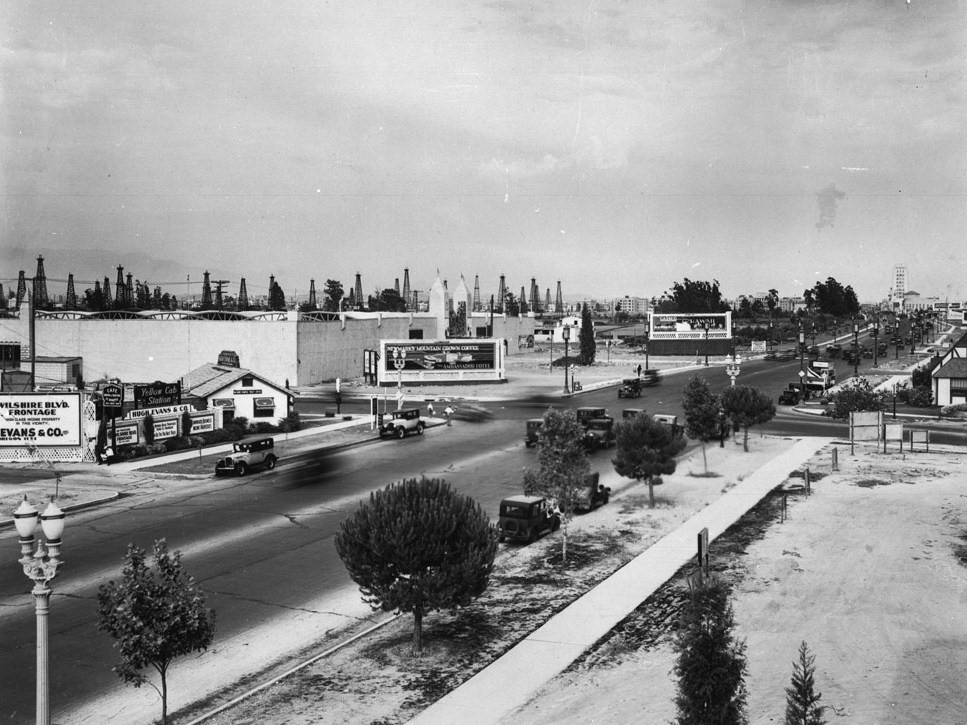 |
|
| (ca. 1929)* - Looking east on Wilshire Boulevard toward its intersection with Fairfax Avenue. The northeast corner with the billboard is where the May Company Department Store would go about 10 years later. On the opposite corner (NW corner) where the little white house is, was once Rogers Airport, and would later become the iconic circular Simon's Drive-in restaurant. It is now the Johnies 50s diner. Oil wells are spread out where Park La Brea is now. |
Historical Notes In the late 1930s the 1.5-mile stretch of Wilshire Boulevard between Fairfax and Highland Avenues would be named the Miracle Mile. |
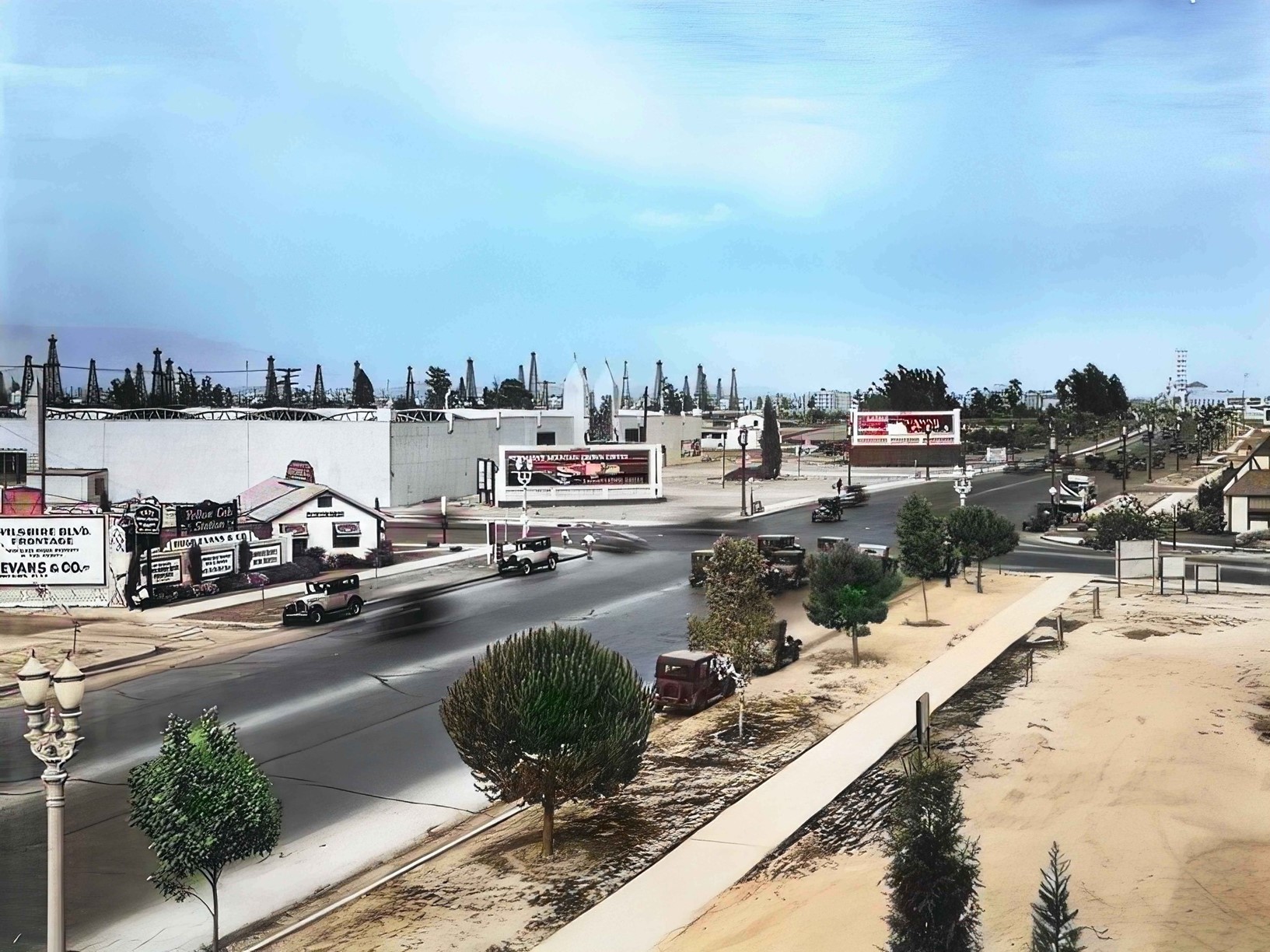 |
|
| (ca. 1929)* - Looking east on Wilshire Boulevard toward its intersection with Fairfax Avenue. The northeast corner with the billboard is where the May Company Department Store would go about 10 years later. On the opposite corner (NW corner) where the little white house is, was once Rogers Airport, and would later become the iconic circular Simon's Drive-in restaurant. It is now the Johnies 50s diner. Oil wells are spread out where Park La Brea is now. Image enhanced and colorized by Richard Holoff |
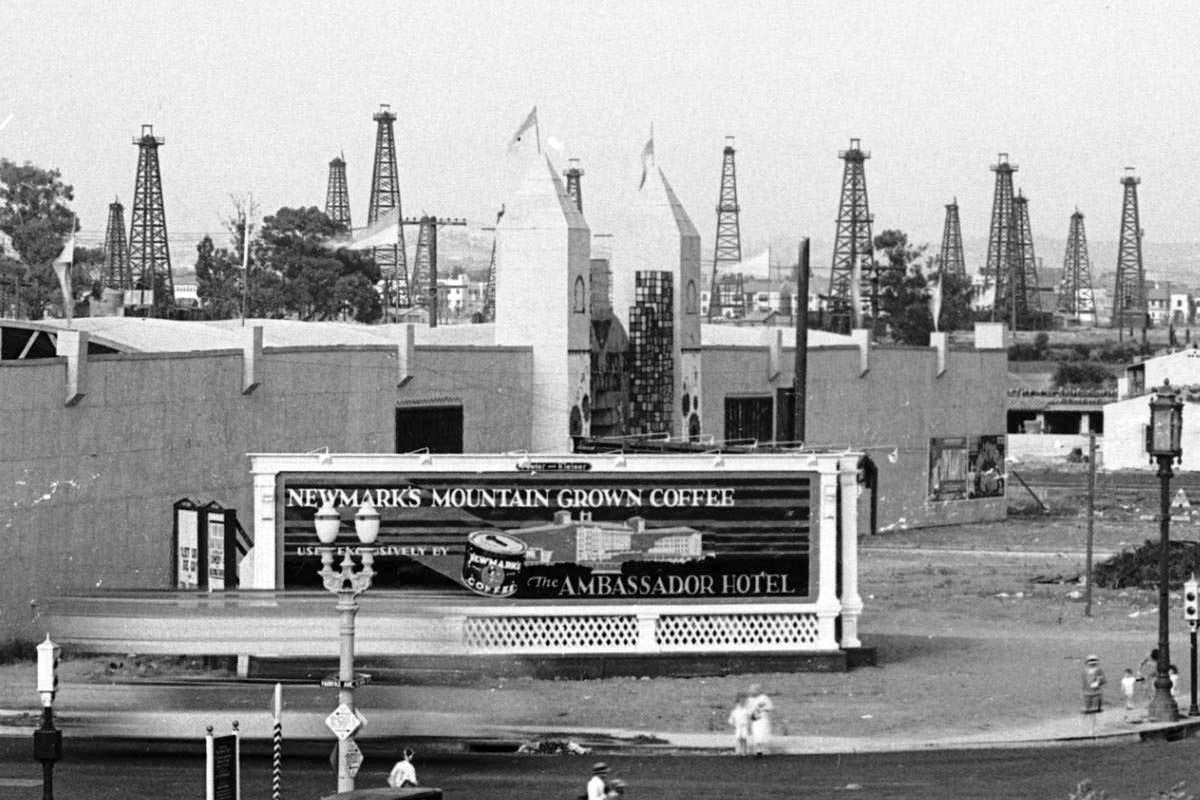 |
|
| (ca. 1929)* – Close-up view of the northeast corner of Wilshire and Fairfax with an unusual shaped building located at the future site of the May Company Building. Signboard in the foreground reads “Newmark’s Mountain Grown Coffee Exclusively Served by the Ambassador Hotel”. Note all the oil derricks in the background. |
 |
|
| (ca. 1929)* - Two towers mark the entrance to this walled structure on the NE corner of Fairfax Avenue and Wilshire Boulevard. The sign above the entrance may include the words "Sports Town." |
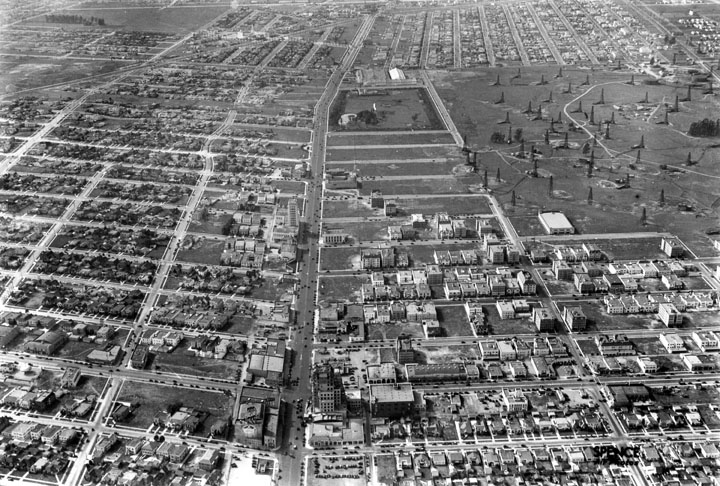 |
|
| (1930)^ - Aerial view looking west down Wilshire Boulevard from above Sycamore. The widest street visible, Wilshire, became known as the Miracle Mile, where most high rises were built through the years. The Salt Lake Oil Field is at upper-right and the La Brea Tar Pits at upper-center. Fairfax runs horizontal at top of photo at the end of the oil field. Farmers Market is out of view in the upper-right. |
Historical Notes Developer A.W. Ross foresaw a grand commercial destiny for western Wilshire Boulevard earlier than anyone else. In the early 1920s, Ross began buying up land along Wilshire Boulevard between La Brea Avenue and Fairfax Avenue, a pursuit some referred to as “Ross’s Folly.” He envisioned a destination shopping district that would lure customers from Beverly Hills as well as Hollywood and downtown Los Angeles, and encouraged the construction of architecturally distinctive commercial buildings. Ross’s development gamble along the western part of Wilshire Boulevard paid off in spades from the late 1920s and through the 1930s, as “Ross’s Folly” became known as Miracle Mile. The area housed large retailers like Desmond’s, Silverwoods, and the May Company, and even supermarkets like Ralph’s boasted flashy architecture on a grand scale. Ross remained a major force in the development of Wilshire Boulevard until the 1960s, seeing the boulevard lure the city’s population ever westward. Click HERE to see more Early Views of the Miracle Mile (1940s & 1950s). |
 |
|
| (1938)^ – Looking NW showing the intersection of Wilshire and Fairfax with Simon’s Drive In Cafe seen on the left (NW corner). The following year construction would begin on the May Company on the lot with the billboard (NE corner). |
Historical Notes Los Angeles Motor Bus (later renamed the Los Angeles Motor Coach Company) was a joint venture of Pacific Electric and Los Angeles Railway that existed from 1923 until 1949. It began in 1923 as Wilshire Boulevard's transit service from the MacArthur Park area to La Brea Avenue and was extended further down Wilshire as the service gained in popularity. Wilshire holds a unique distinction—it was the only street in Los Angeles banned from having street rail. Henry Wilshire, when he began developing a 35-acre tract stretching west from Westlake (now MacArthur) Park for an exclusive subdivision, donated to the city an almost quarter-mile long strip of land for a boulevard, conditioned on its being named for him and with the following being banned: rail lines and trucking, heavy and industrial. He didn’t want to discourage the very wealthy prospective buyers he sought to attract. |
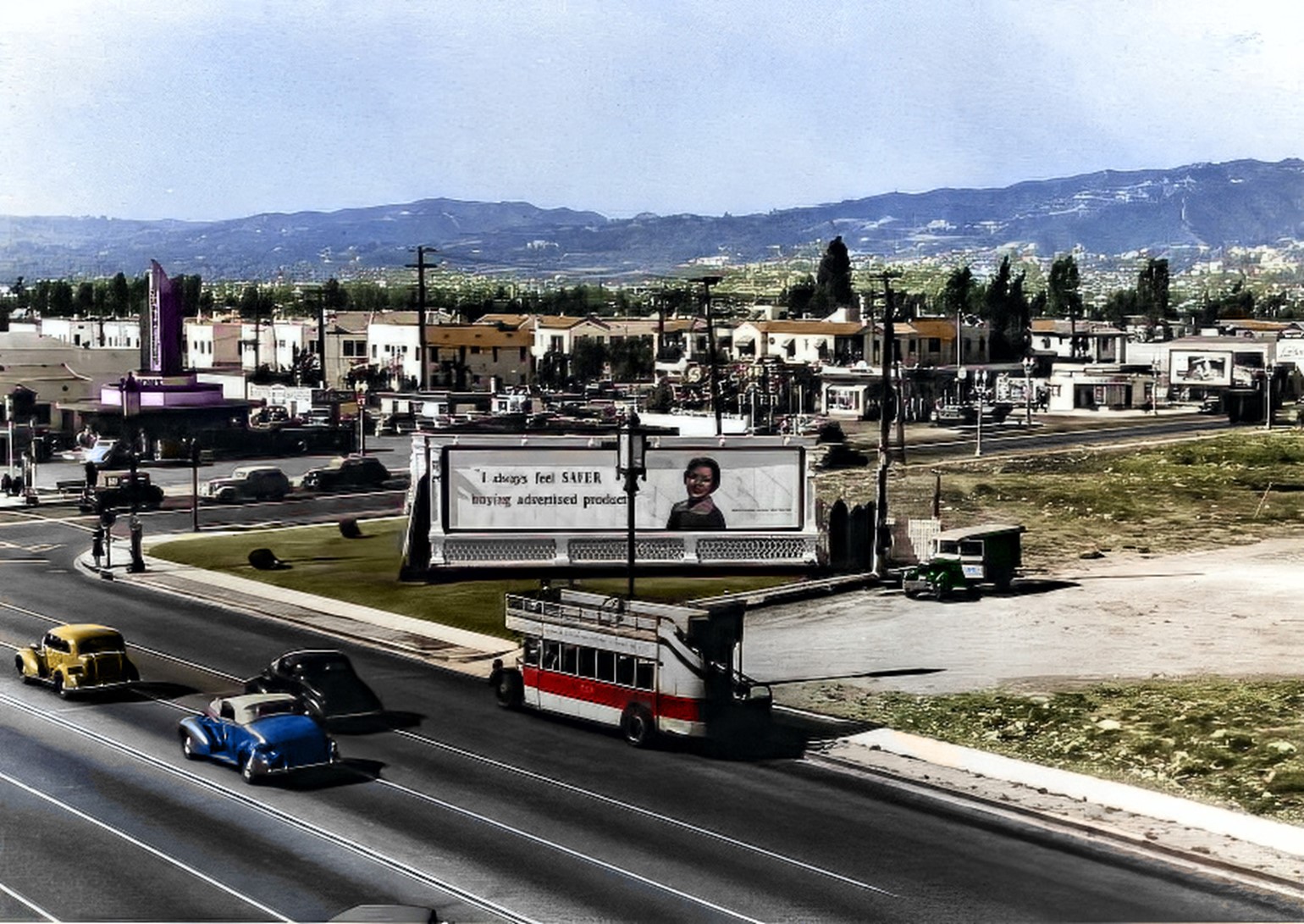 |
|
| (1938)* - A double-decker bus is parked by the curb near the intersection of Wilshire and Fairfax. Large signboard reads: ‘I always feel SAFER buying advertixed products’. Image enhancement and colorization by Richard Holoff |
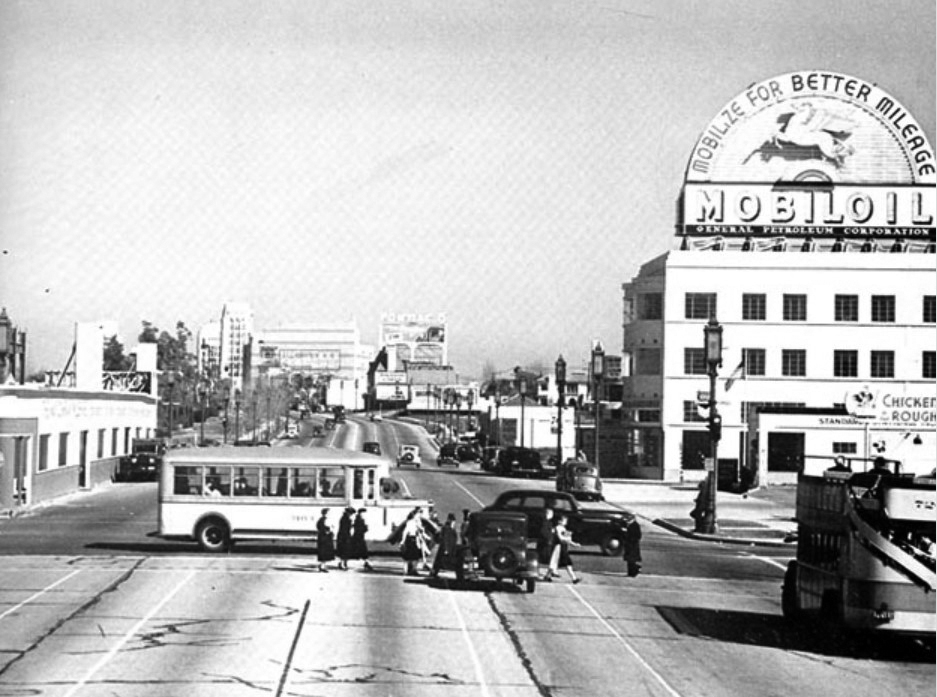 |
|
| (1938)* – View looking east on Wilshire Boulevard at Fairfax Avenue. At right is a double-decker bus on the Los Angeles Motor Coach Wilshire Line and crossing Wilshire is a bus on the Fairfax Avenue line. The building on the right with the rooftop Mobil Gas billboard is the 6030 Wilshire building (later the location of the A+D Museum). On the left (NE corner) can be seen what appears to be a single story building but is really a facade in front of the construrction site for the new May Compnay Building (Completed in 1940). To the right of the double-decker bus, on the SW corner and out of view, is a Gilmore gas station. |
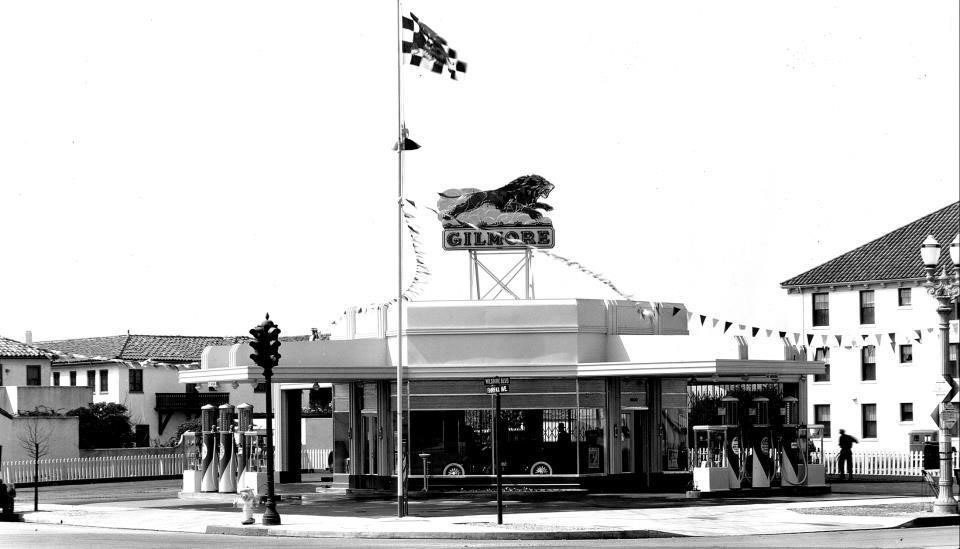 |
|
| (1930s)* – Looking at the SW corner of Wilshire and Fairfax showing a Gilmore gas station. The building on the right (The Carthay Apartments) is still standing. A 16-story high rise stands at this corner today. |
Historical Notes The Gilmore family is a longtime Los Angeles institution, having acquired the Rancho La Brea in the mid 19th century. In the early 20th century, oil discoveries on Gilmore land brought about a new fortune in petroleum. The Gilmore family went on to establish Farmers Market, which was built alongside the original Gilmore Adobe. They also established the Gilmore Bank, built Gilmore Field for the Hollywood Stars, a minor league baseball team, and also sponsored midget race cars on a small race track. Both the field and the racetrack were later replaced by CBS Television City. At one time there were more than 1,100 Gilmore Gas Statons throughout the West that sold only Gilmore products and another 2,400 that sold them along with other brands. The clear glass globes at the top of gas pumps allowed the color of the gasoline to be seen. E.B. Gilmore jumped on this unique opportunity to become the first oil company to market its gas by its color. Blu-Green and Red Lion Gas fueled the cars and imaginations of West Coasters from the ’20s to the early ’40s. Click HERE to see more Early LA Gas Stations. |
.jpg) |
|
| (1939)* – View looking East on Wilshire at Fairfax showing the May Co. Dept. Store under construction on the NE corner. Note the double decker bus on the right. A sign for Simon's Drive-in can be seen across the street on the NW corner. |
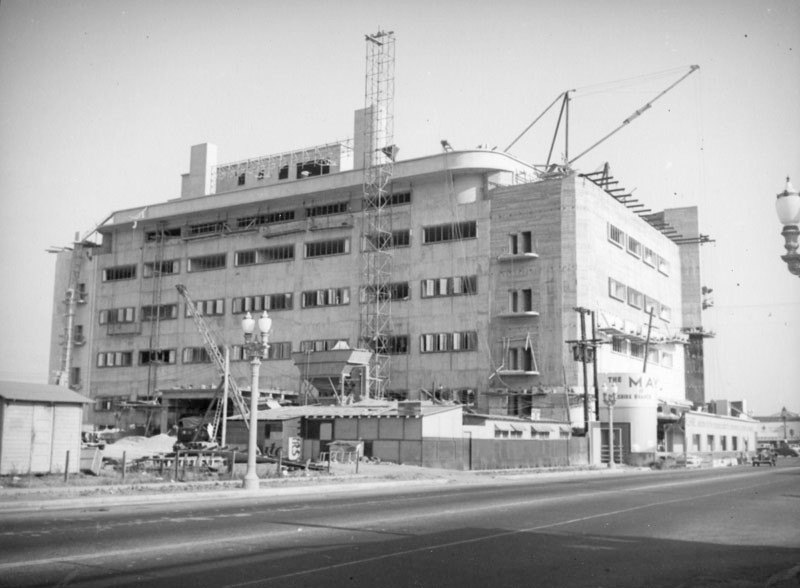 |
|
| (1939)* - Looking across Fairfax Avenue toward the northeast corner of Fairfax and Wilshire showing cranes and scaffolding surrounding the Wilshire May Company store still under construction. |
Historical Notes Albert C. Martin and Samuel A. Marx designed the 1939 Streamline Moderne style May Company department store, located at 6067 Wilshire Boulevard. Martin also designed the Million Dollar Theatre and Los Angeles City Hall. |
Then and Now
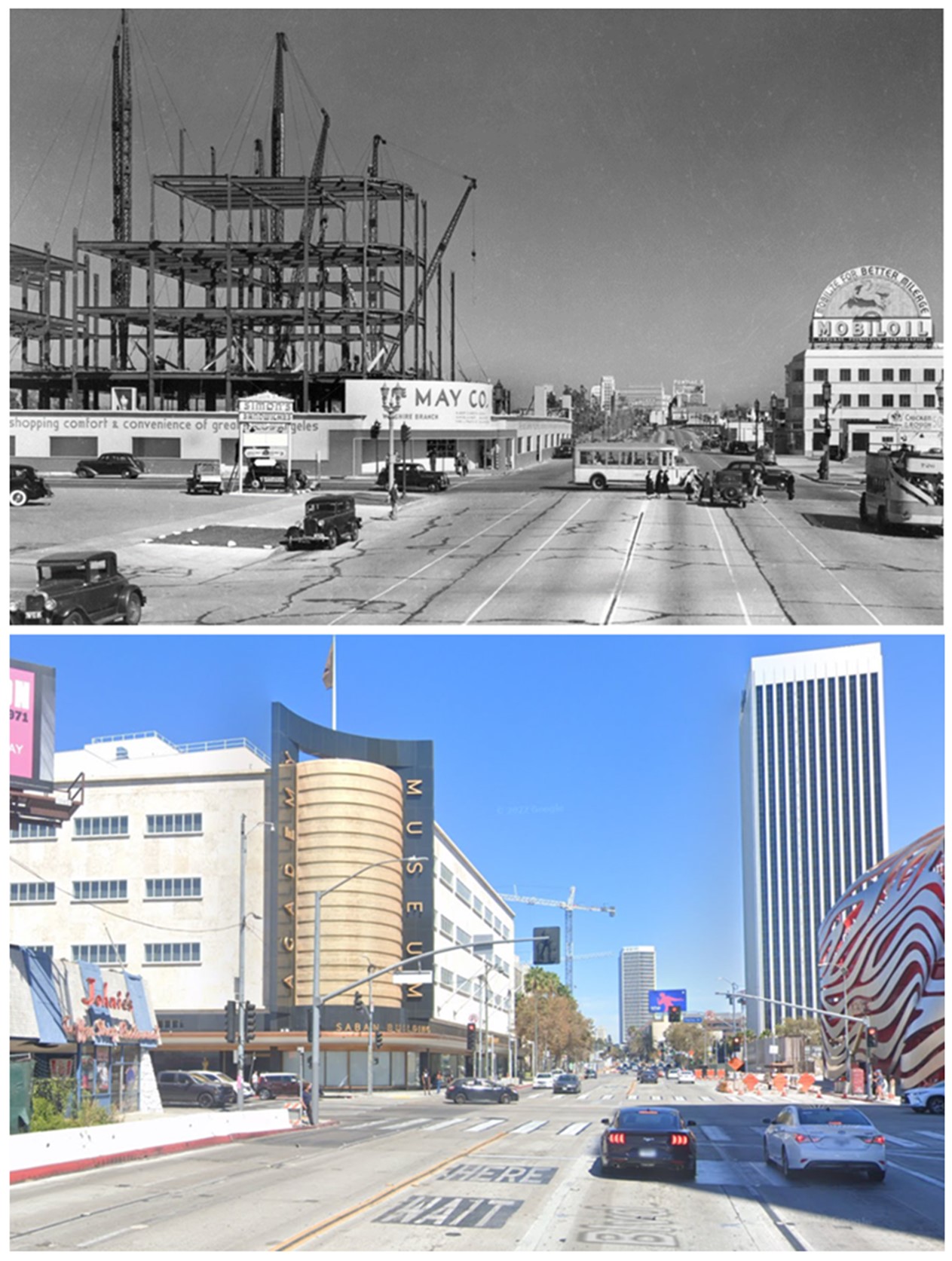 |
|
| (1939 vs 2022)* – Looking east on Wilshire Blvd at Fairfax Ave showing the May Co. Dept. Store under construction, today the Academy Museum of Motion Pictures. Photo comparison by Jack Feldman. |
.jpg) |
|
| (1940)*– Aerial view showing the May Company Department Store, NE corner of Wishire and Fairfax, shortly after its opening. Across Fairfax (NW corner) can be seen the popular Simon's Drive-in restaurant where the Googie-influenced Johnie's Coffee Shop now stands. |
 |
|
| (ca. 1940)* - May Co. Department Store, located on the northeast corner of Wilshire and Fairfax. A man appears to be standing on top of the May Co. sign. A sign for Simon's Sandwiches can be seen at lower-left (NW corner). |
Historical Notes When it opened, the gleaming May Company building was instantly heralded as the western gateway to the Miracle Mile, beckoning to motorists with an enormous gold-tiled cylinder at the corner of Fairfax Avenue. |
 |
|
| (1940s)**^ - Looking toward the northeast corner of Wilshire and Fairfax where the beautiful May Company Department Store Building stands. |
Historical Notes May Company California was established in 1923 when May acquired A. Hamburger & Sons Co.(founded in 1881 by Asher Hamburger). The company operated exclusively in Southern California until 1989 when May Department Stores had dissolved Goldwater's, based in Scottsdale, Arizona and transferred its Las Vegas, Nevada store to May Company California. |
 |
|
| (1939)* - Simon's Drive-in Restaurant on the northwest corner of Fairfax Avenue and Wilshire Boulevard. This is an engineering notebook photoprint taken from top deck of Wilshire Boulevard Bus. |
Historical Notes Simon's Drive-in Restaurant was built in 1935 and looks very similar to many of the other drive-ins built in the 1930s. That's because so many of these futuristic looking drive-ins were designed by architect Wayne McAllister. Wayne McAllister was a Los Angeles-based architect who was a leader in the Googie style of architecture that embraced the automobile and the Space Age. Inspired by tail fins and gleaming chrome, he elevated the drive-in restaurant to futuristic works of art. He created iconic circular drive-in restaurants in Southern California, including Simon's, Herbert's, Robert's, and McDonnell's in the 1930s. |
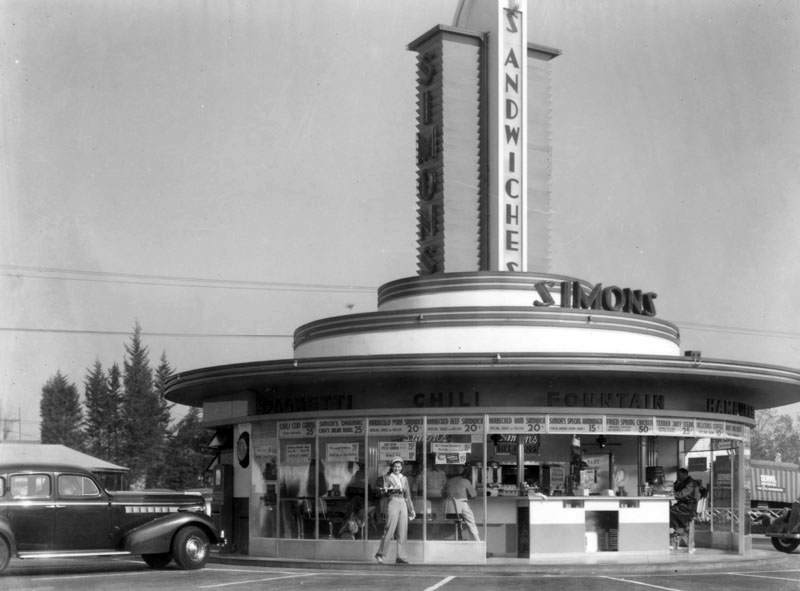 |
|
| (1939)^ - A daytime view of Simon's Drive-in Restaurant located on the northwest corner of Fairfax and Wilshire. Through the glass floor-to-ceiling windows, patrons can be seen sitting at the circular counter having their meals. "Spaghetti", "Chili", "Fountain", "Hamburgers" and "Barbecue" can be seen above the windows. A carhop is standing at front, holding food in her hand. |
Historical Notes At one time Simon's Drive-ins dominated the Southern California drive-in restaurant craze. The Simon brothers had operated a chain of successful dairy lunch counters in downtown Los Angeles, and in 1935 decided to capitalize on the growing car culture of Los Angeles by opening auto friendly locations in the emerging commercial centers of Wilshire Boulevard, Sunset and Ventura Boulevards. Click HERE to see more Early LA Drive-in Restaurants. |
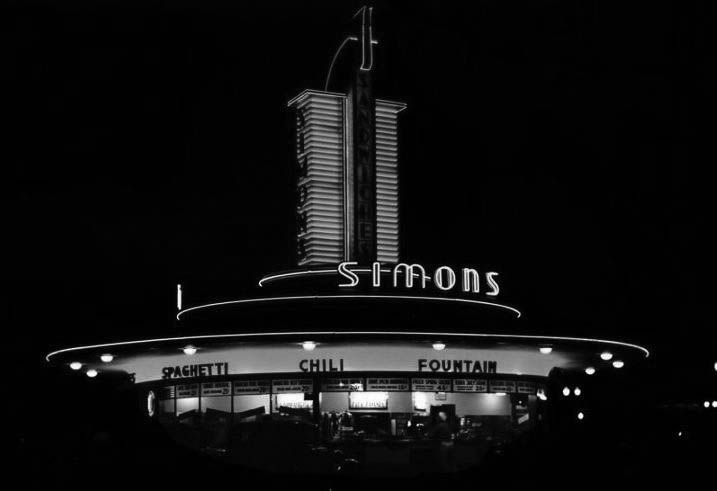 |
|
| (ca. 1940s)* - Night view showing the neon-lit Simon's Drive-in Restaurant at Fairfax and Wilshire, NW corner. |
Historical Notes This is the same corner where the 1950s Johnie's Coffee Shop now stands. Across the street is the old May Company department store building which is now a part of LACMA/the Hollywood Museum. Going back further to the early 1900s, this is where the Chaplin Airfield was once located (Click HERE to see more in Aviation in Early L.A.). |
 |
|
| (1948)* – A couple of jitter-bugs down at Simon's Drive-in wowing the waitress with their zebra-stripe upholstery. Photo courtesy of Curbside Classic |
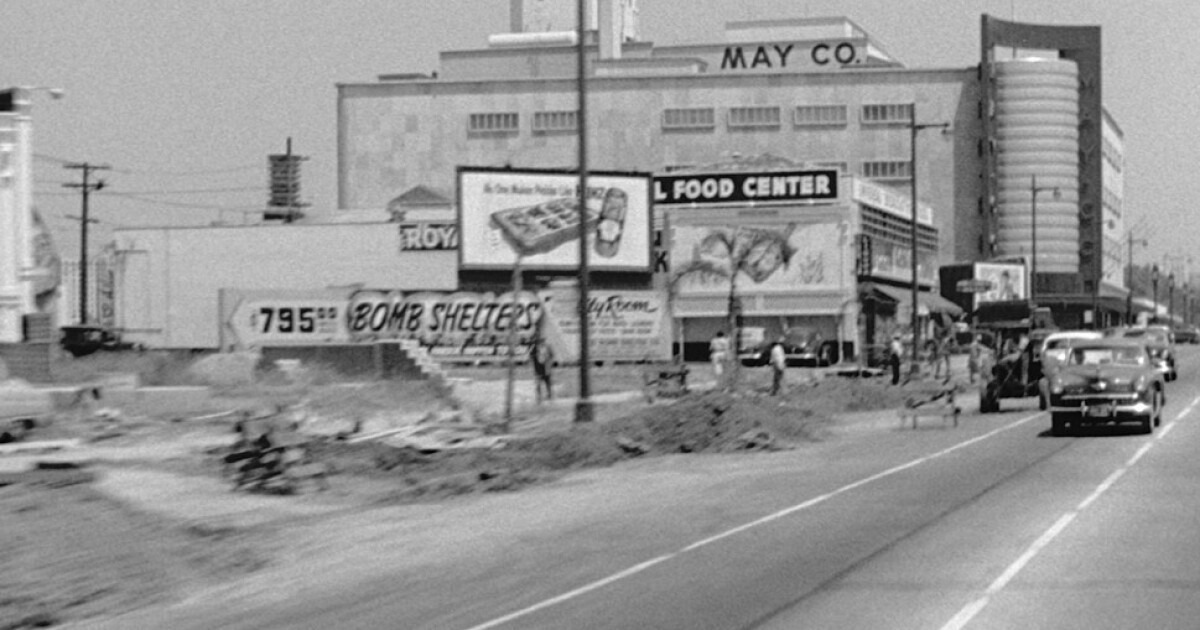 |
|
| (ca.1951)* - Looking east on Wilshire Blvd toward Fairfax Ave with the Royal Food Center and May Company in the background. Note the billboard on the left advertising “BOMB SHELTERS” for $795. LA Times Photo |
Historical Notes The bomb shelter craze, also known as the fallout shelter craze, occurred primarily during the 1950s and 1960s. This period was characterized by heightened tensions and fears related to the Cold War between the United States and the Soviet Union. The development and testing of nuclear weapons, as well as the threat of a potential nuclear conflict, led many people to seek ways to protect themselves and their families in the event of a nuclear attack. |
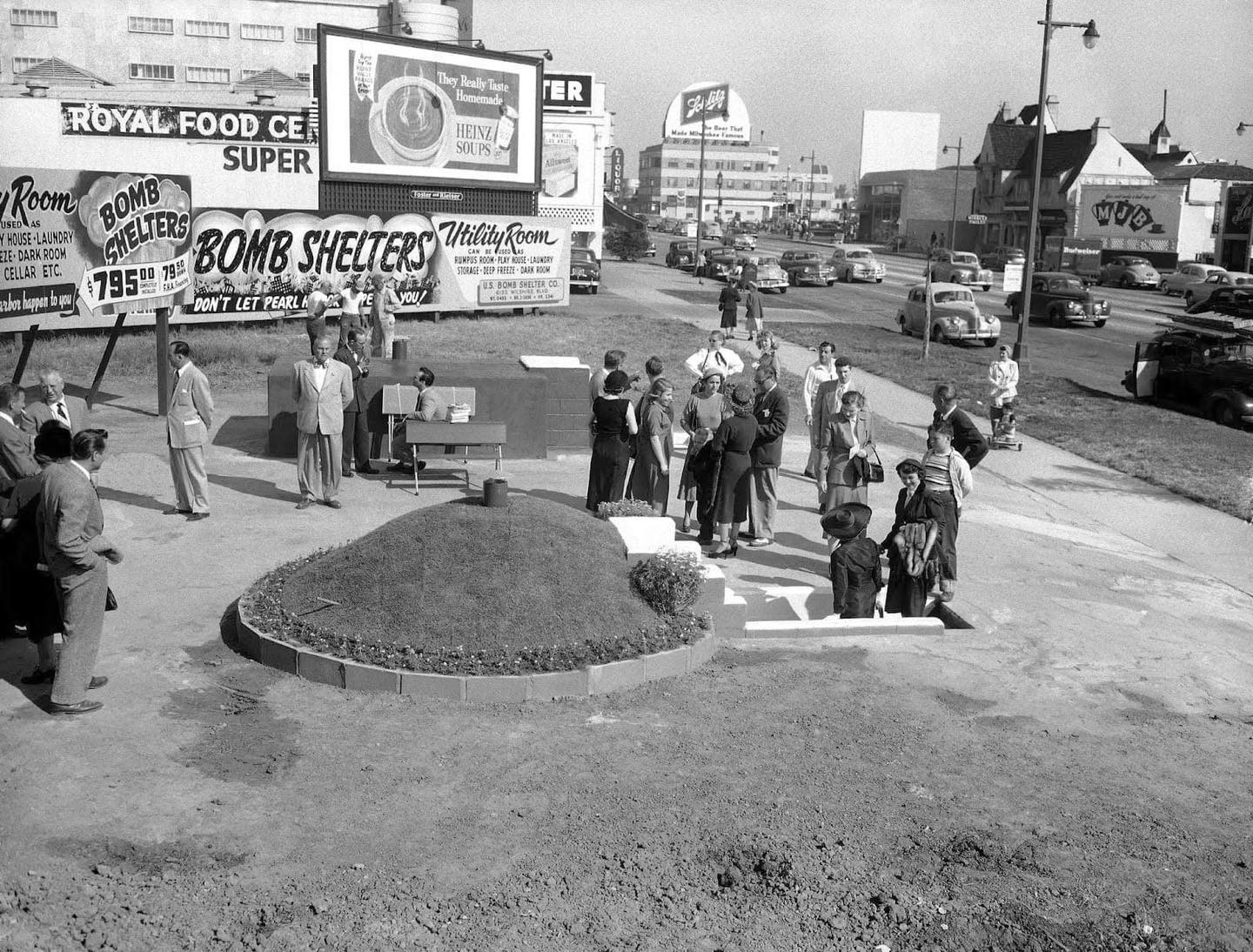 |
|
| (1951)* - Salesmen showing off newest design in bomb shelters near the intersection of Wilshire and Fairfax. Photo Don Brinn/AP |
Historical Notes The bomb shelter craze reached its peak in the early 1960s during the Cuban Missile Crisis in 1962, when the United States and the Soviet Union came to the brink of nuclear war. This event heightened the sense of urgency and increased the demand for bomb shelters. The government encouraged citizens to build their own shelters, and there were various public and private initiatives promoting the construction of fallout shelters. |
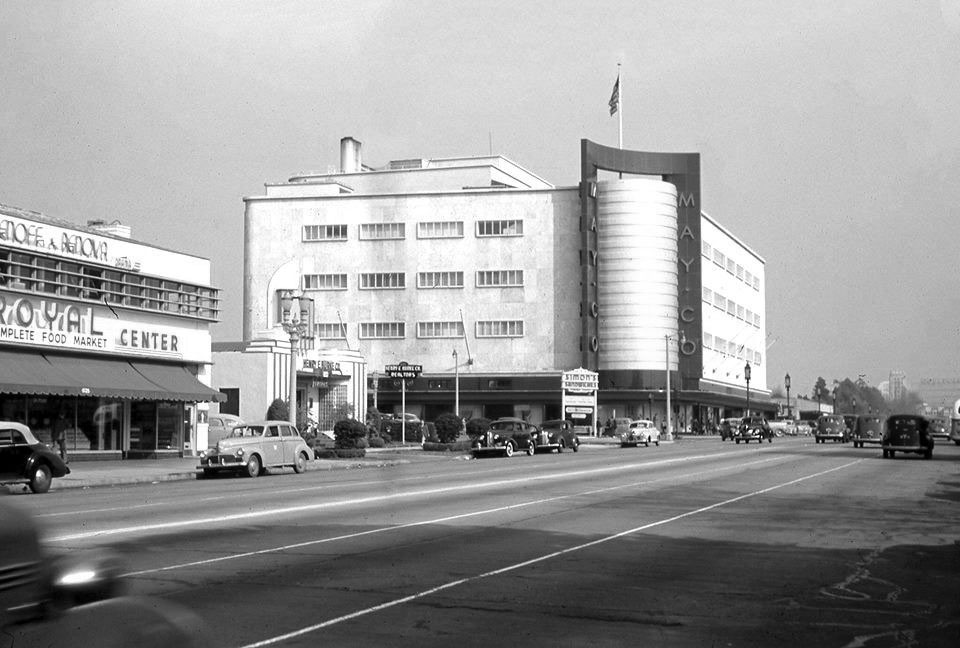 |
|
| (1944)* – Looking east on Wilshire Blvd towards Fairfax Ave showing May Company on the NE corner. Across the street (N/W corner) can be seen Simon’s Sandwiches drive-in restaurant. Next to Simon’s is the Art Deco Krandill Mortgage and Investment Company building. |
Historical Notes A. W. Ross saw potential for the area and developed Wilshire as a commercial district to rival downtown Los Angeles. Ross's insight was that the form and scale of his Wilshire strip should attract and serve automobile traffic rather than pedestrian shoppers. He applied this design both to the street itself and to the buildings lining it. |
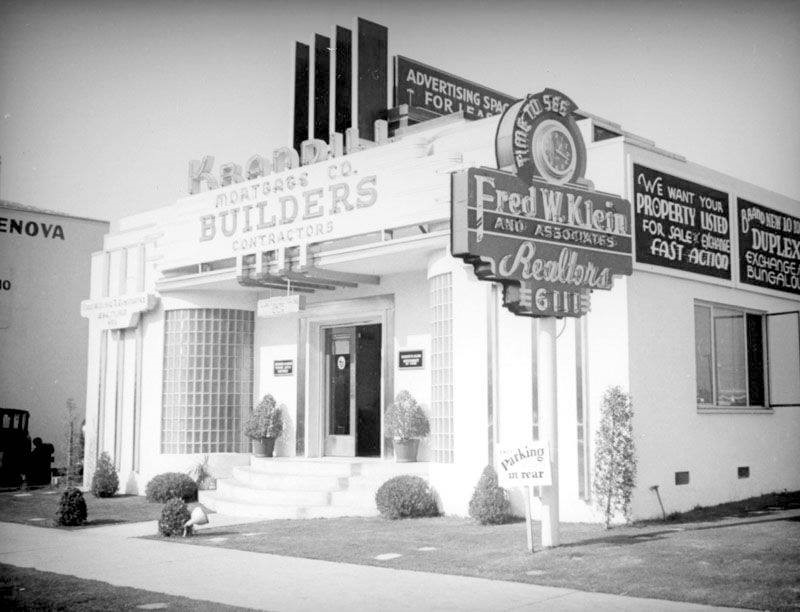 |
|
| (ca. 1937)* – Krandill Mortgage and Investment Company featuring builders and contractors is located at 6111 Wilshire Boulevard near Fairfax, just West of Simon’s Drive-in. The Streamline Moderne building features a rounded glass brick entrance and stepped neon sign. A neon clock pole sign announces that it is time to see Fred W. Klein and Associates, Realtors. The rooftop billboard space is for lease, and has interesting Late Moderne features that have been integrated into the building. |
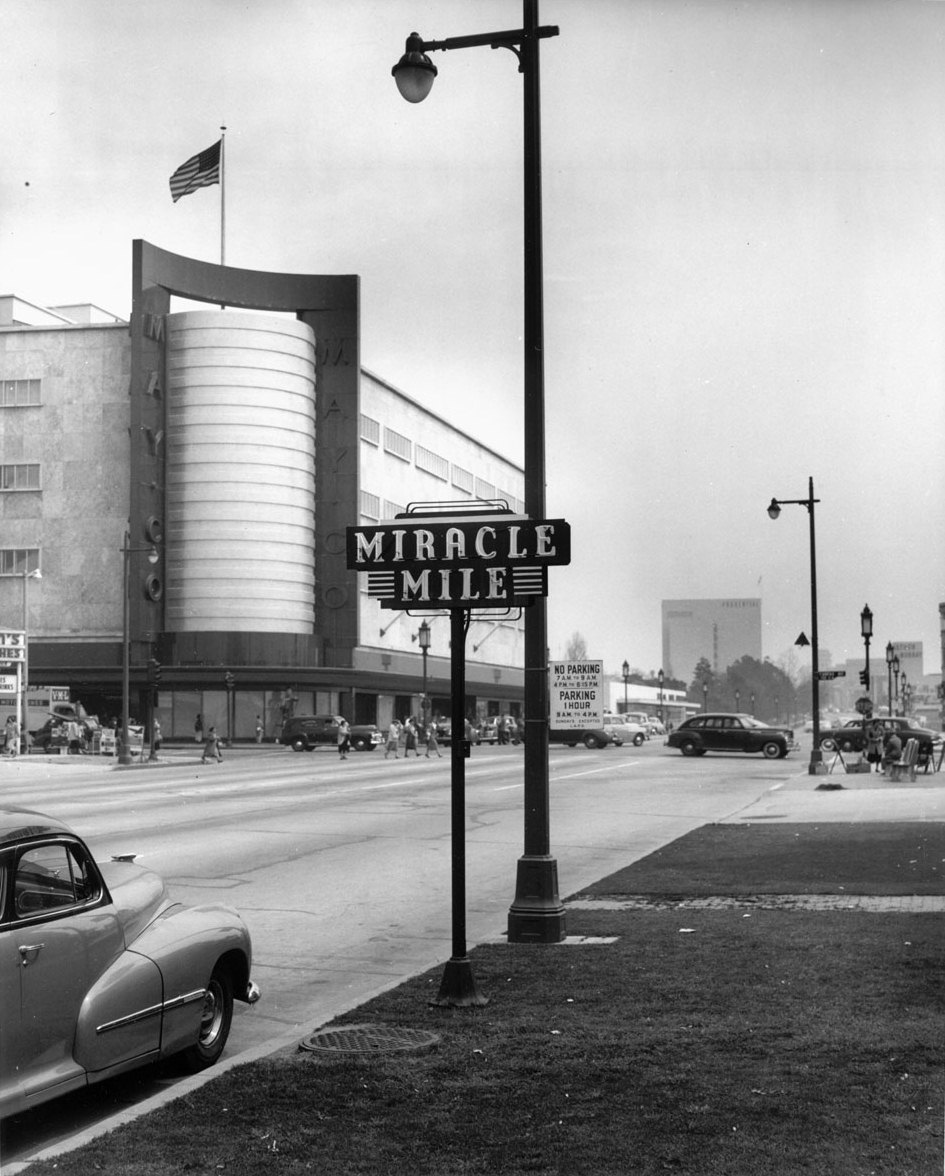 |
|
| (1948)*# - View of the Miracle Mile and the May Company Building, looking east down Wilshire Boulevard. Different styles of streetlights run up and down Wilshire Boulevard. Click HERE to see more in Early Los Angeles Street Lights. |
Historical Notes The Miracle Mile development was initially anchored by the May Company Department Store with its landmark 1939 Streamline Moderne building on the west and the E. Clem Wilson Building on the east, then Los Angeles's tallest commercial building. |
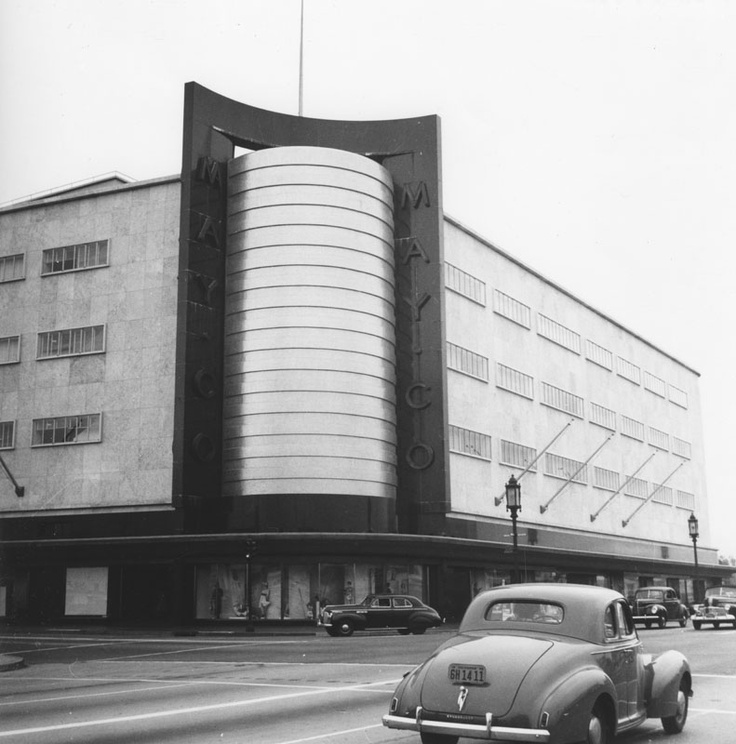 |
|
| (1940s)^ - View looking at the intersection of Fairfax Avenue and Wilshire Boulevard. The May Company Building can be seen on the northeast corner. |
Historical Notes The May Company Building has a Streamline Modern style with gold corner towers. Built in 1940. Architects: A.C. Martin, S.A. Marx. In 1992, the building was designated LA Historic-Cultural Monument No. 566 (Click HERE to see complete listing). |
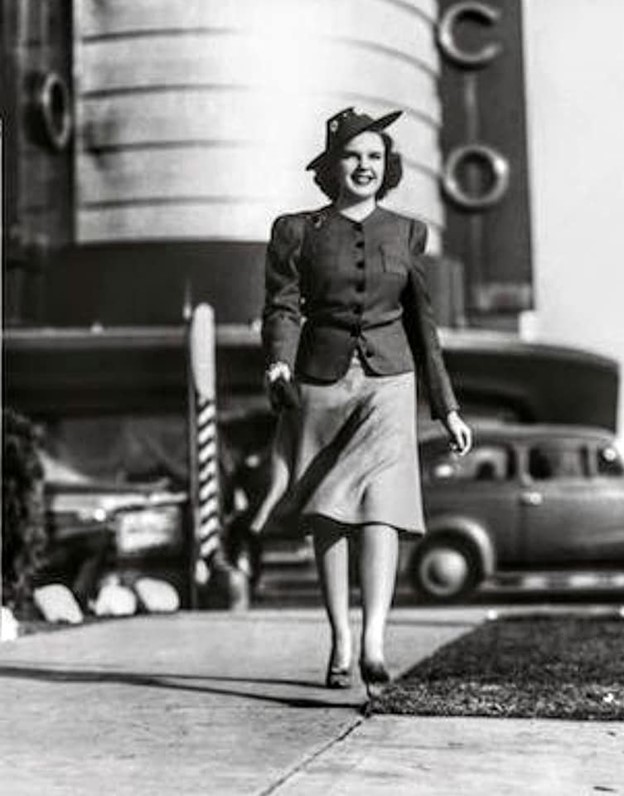 |
|
| (1940)* - Judy Garland on Wilshire Blvd just west of Fairfax with May Company department store seen in the background. Photo courtesy of Paul Wright |
 |
|
| (1940s)* – Postcard view looking East on Wilshire toward Fairfax with the May Co. store standing tall on the NE corner. A sign for "Miracle Mile" is seen at right; Mobilgas service station at right (SW corner); Simon’s Drive-in on the left (NW corner); also seen is an over-sized billboard advertising Cresta Blanka wine across from the May Co. |
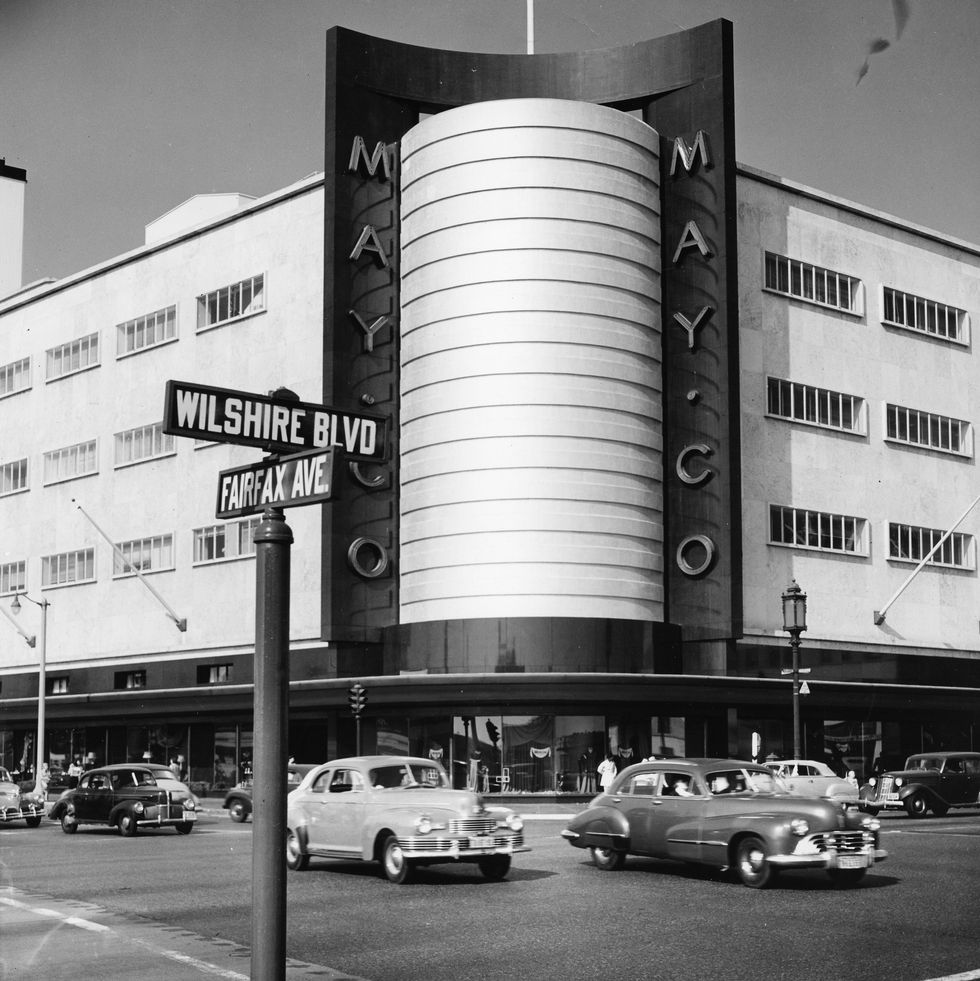 |
|
| (1940s)* - Wilshire and Fairfax looking Northeast toward the May Co. Building. Photo courtesy of the Margaret Herrick Library |
Historical Notes May Company California was established in 1923 when May acquired A. Hamburger & Sons Co.(founded in 1881 by Asher Hamburger). The company operated exclusively in Southern California until 1989 when May Department Stores had dissolved Goldwater's, based in Scottsdale, Arizona and transferred its Las Vegas, Nevada store to May Company California. |
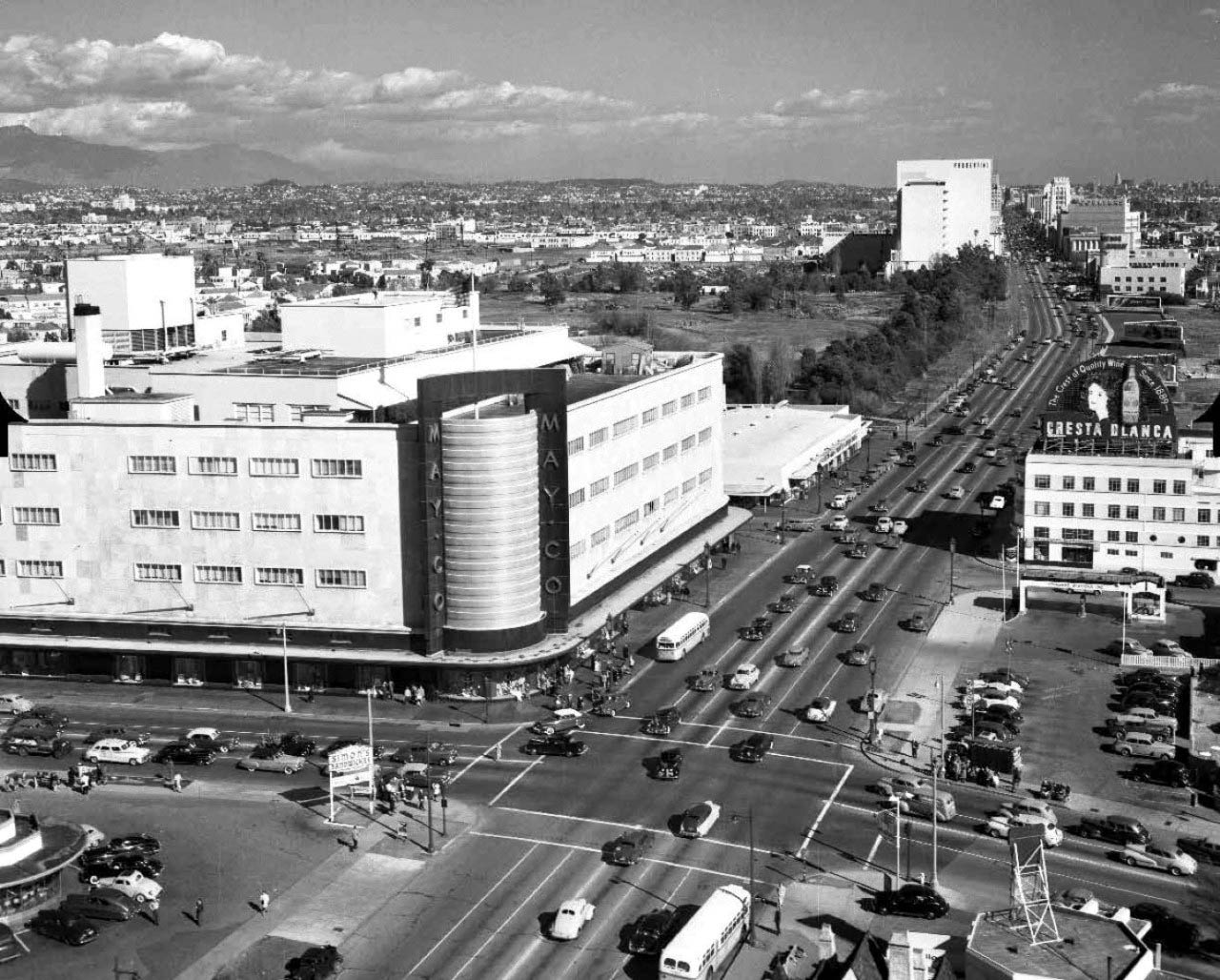 |
|
| (1940s)* – Aerial view of Wilshire Blvd facing east at Fairfax Ave, showing the May Company department store on the NE corner. Simon's Drive-in can be seen at lower-left on the NW corner. This intersection was, and still is, referred to as the western gateway to the Miracle Mile. Source: Bison Archives |
Historical Notes It was not until 1928 that the Miracle Mile acquired its glamorous appellation. Ross originally gave his development a much less-memorable name: Wilshire Boulevard Center. According to a story Ross was describing his vision for the development when a friend interjected: "From the way you talk, A.W., one would think this is really a miracle mile." The name, with its obvious promotional value, stuck. |
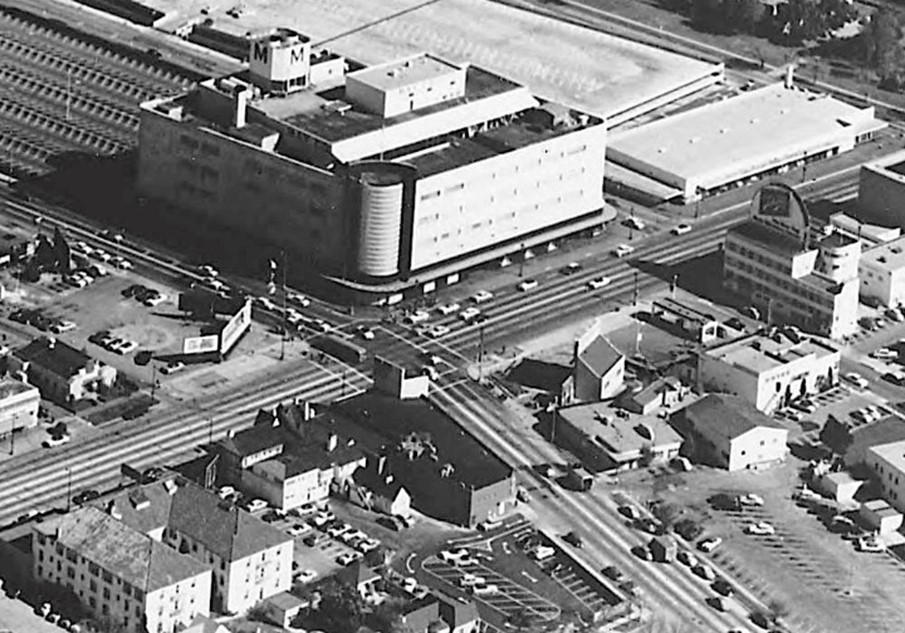 |
|
| (1954)* – Aerial bird’s-eye view of the busy intersection of Fairfax Ave and Wilshire Blvd in 1954. The May Co. department store, which opened in 1939 on the northeast corner, dominated the corner then as it does now. We can see their huge parking lot behind and to the east. The popular Simon’s drive-in that stood on the northwest corner during the 30s and 40s is now gone, and not yet replaced by Johnie’s. On the other side of the May Co (top-right of photo), there is a long flat building. This was May Company's home appliance department. |
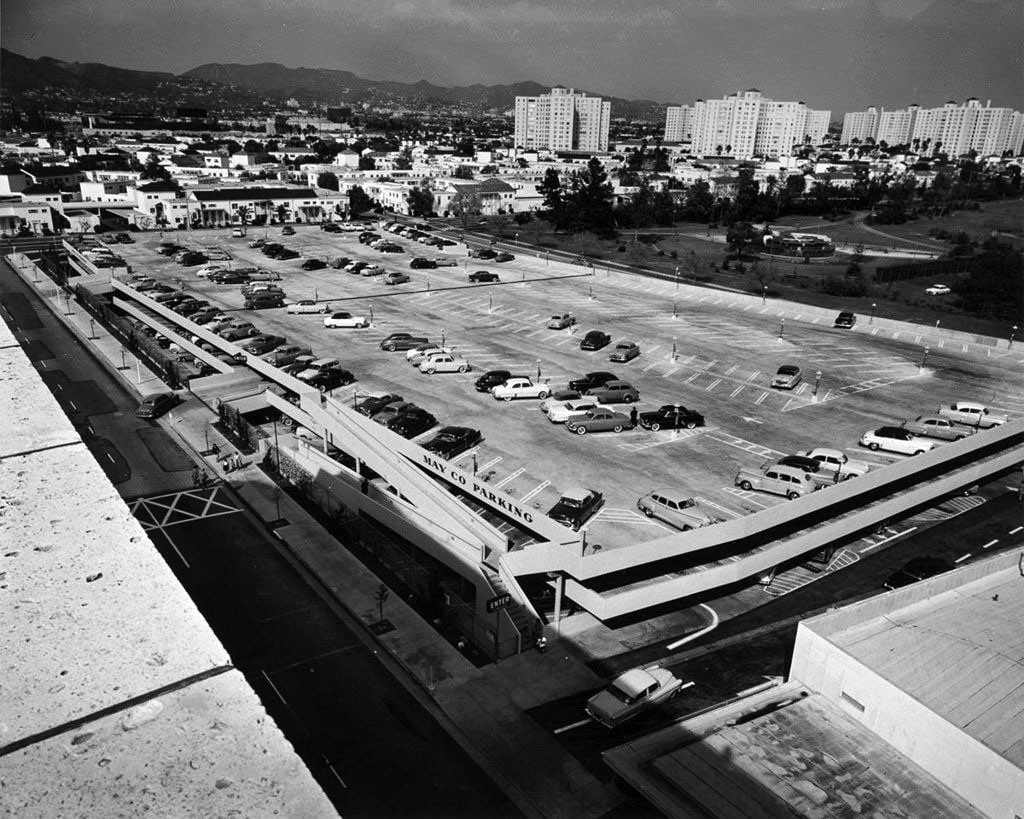 |
|
| (ca. 1953)* – View looking northeast from the roof of the May Co. Building showing multi-level store parking below, the Park La Brea Towers, and the Hollywood Hills in the distance. Photo by Julius Shulman via Getty Collection |
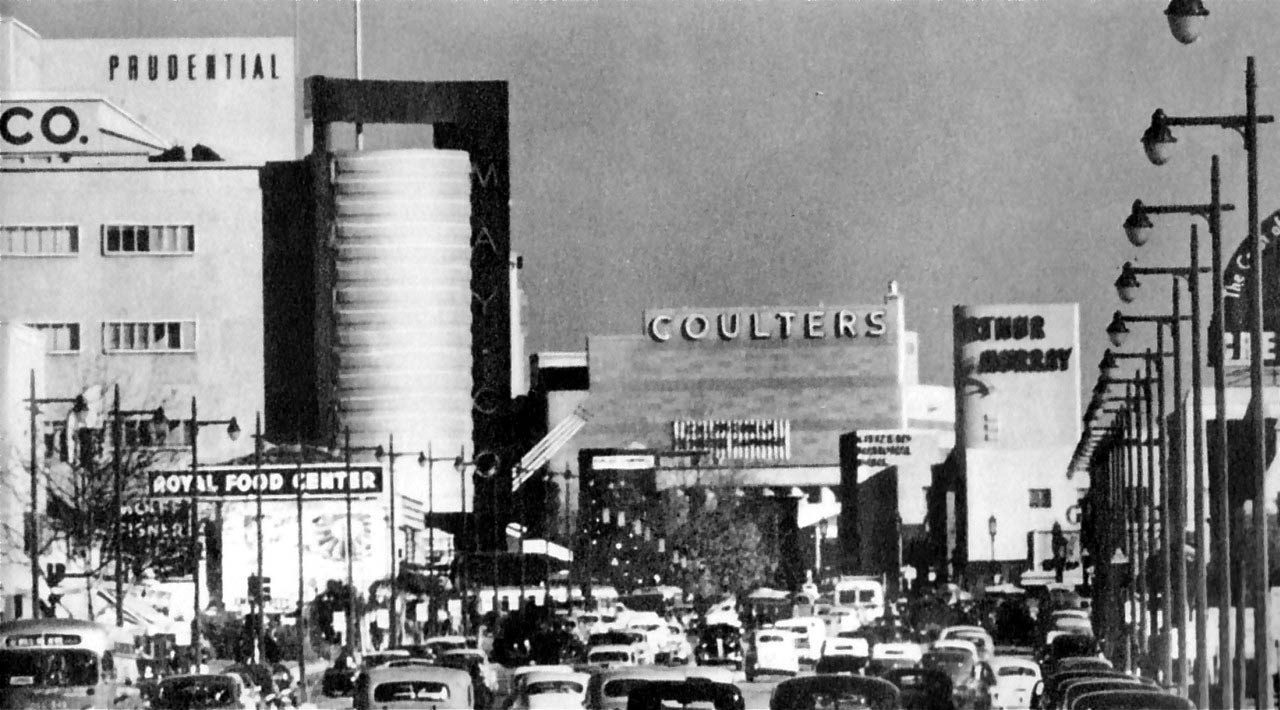 |
|
| (1940s)* – Panoramic view using telephoto lense looking east on Wilshire Boulevard through the Fairfax Avenue intersection. We can see the May Company department store (now part of LACMA and future home of the Hollywood museum of the Academy of Motion Picture Arts and Sciences), Prudential Building, Coulter's Department Store, and the Arthur Murray Dance Studio. This “Miracle Mile” stretch of Wilshire Blvd is busy now but back then it looks positively jam-packed! |
Historical Notes Ross gave Wilshire various "firsts," including dedicated left-turn lanes and timed traffic lights, the first in the United States. He also required merchants to provide automobile parking lots, all to aid traffic flow. Major retailers such as Desmond's, Silverwood's, May Co., Coulter's, Mullen & Bluett, Myer Siegel, and Seibu eventually spread down Wilshire Boulevard from Fairfax to La Brea. Ross ordered that all building facades along Wilshire be engineered so as to be best seen through a windshield. This meant larger, bolder, simpler signage and longer buildings in a larger scale. They also had to be oriented toward the boulevard and architectural ornamentation and massing must be perceptible at 30 MPH instead of at walking speed. These building forms were driven by practical requirements but contributed to the stylistic language of Art Deco and Streamline Moderne. |
 |
|
| (1950)* – Looking north on Fairfax Ave at Wilshire Boulevard with Simon’s Drive-in on the NW corner. |
Historical Notes This is the same corner where the 1950s Johnie's Coffee Shop now stands. Across the street is the old May Company department store building which is now a part of LACMA/the Hollywood Museum. Going back further to the early 1900s, this is where the Chaplin Airfield was once located (Click HERE to see more in Aviation in Early L.A.). |
.jpg) |
|
| (1964)* – Dashboard view looking east on Wilshire Blvd toward Fairfax showing a Cadillac and Corvair in front of the camera. The 27-story California Federal Bank Building can be seen in the distance and is still under construction. Rams Coffee Shop is now on the NW corner of Wilshire and Fairfax, where Simon’s once stood. |
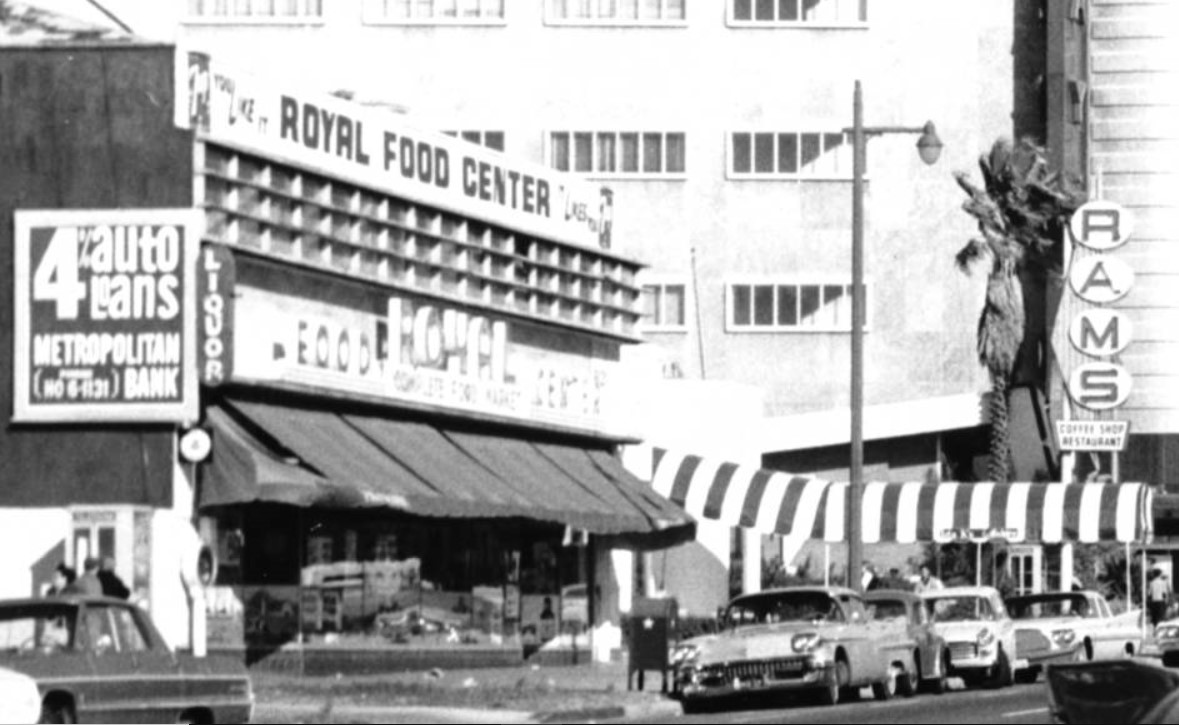 |
|
| (1964)* – Blow-up view showing the north side of Wilshire, just west of Fairfax, with Rams Coffee Shop on the corner where Simon’s used to be. On the left is Royal Food Center. |
Historical Notes Romeo’s Times Square opened on the NW corner of Fairfax and Wilshie in 1956. It was in business only a few years, becoming Rams Coffee Shop in the early 1960s, and Johnie’s shortly thereafter. |
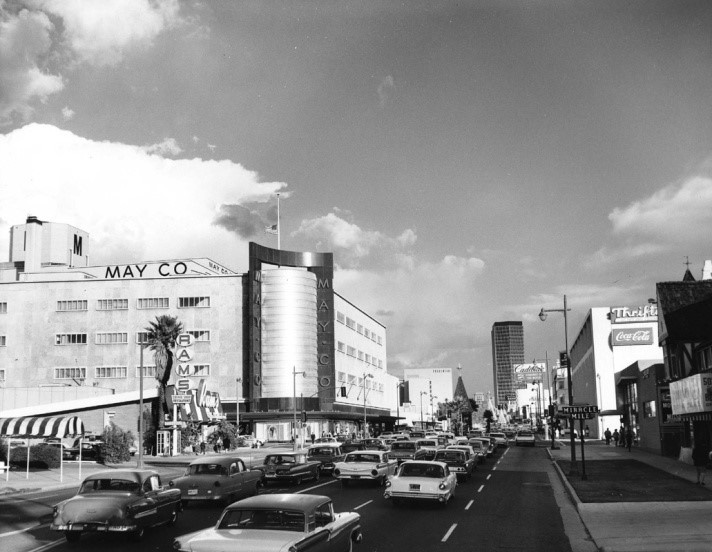 |
|
| (ca. 1965)* – View looking east on Wilshire toward Fairfax. Rams Coffee Shop is seen on the NW corner of Wilshire and Fairfax. The 27-story California Federal Bank Building (completed in 1965) can be seen in the distance. A Thrifty store appears to be on the SW corner where at one time a Gilmore Gas Statioin once stood. Photo courtesy of Miracle Mile Residential Association |
Then and Now
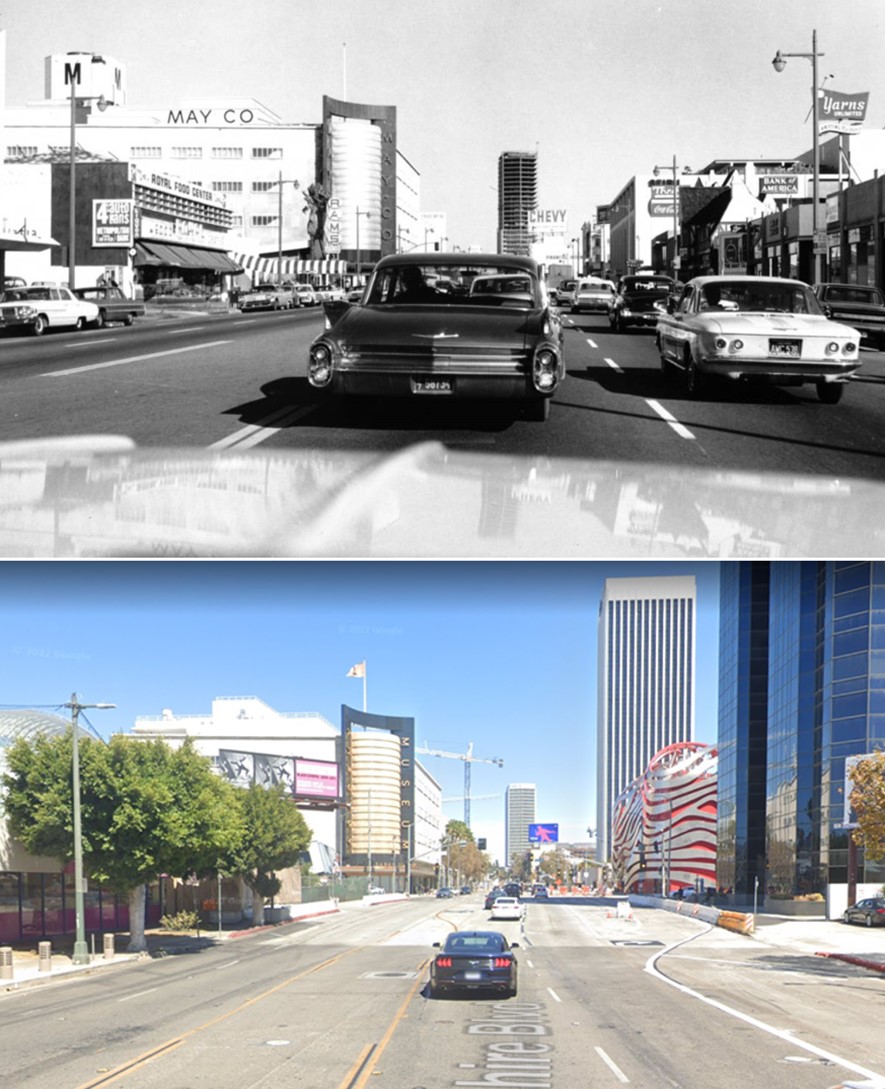 |
|
| (1964 vs 2022)* - Looking east on Wilshire Blvd toward Fairfax Ave. Photo comparison by Jack Feldman. |
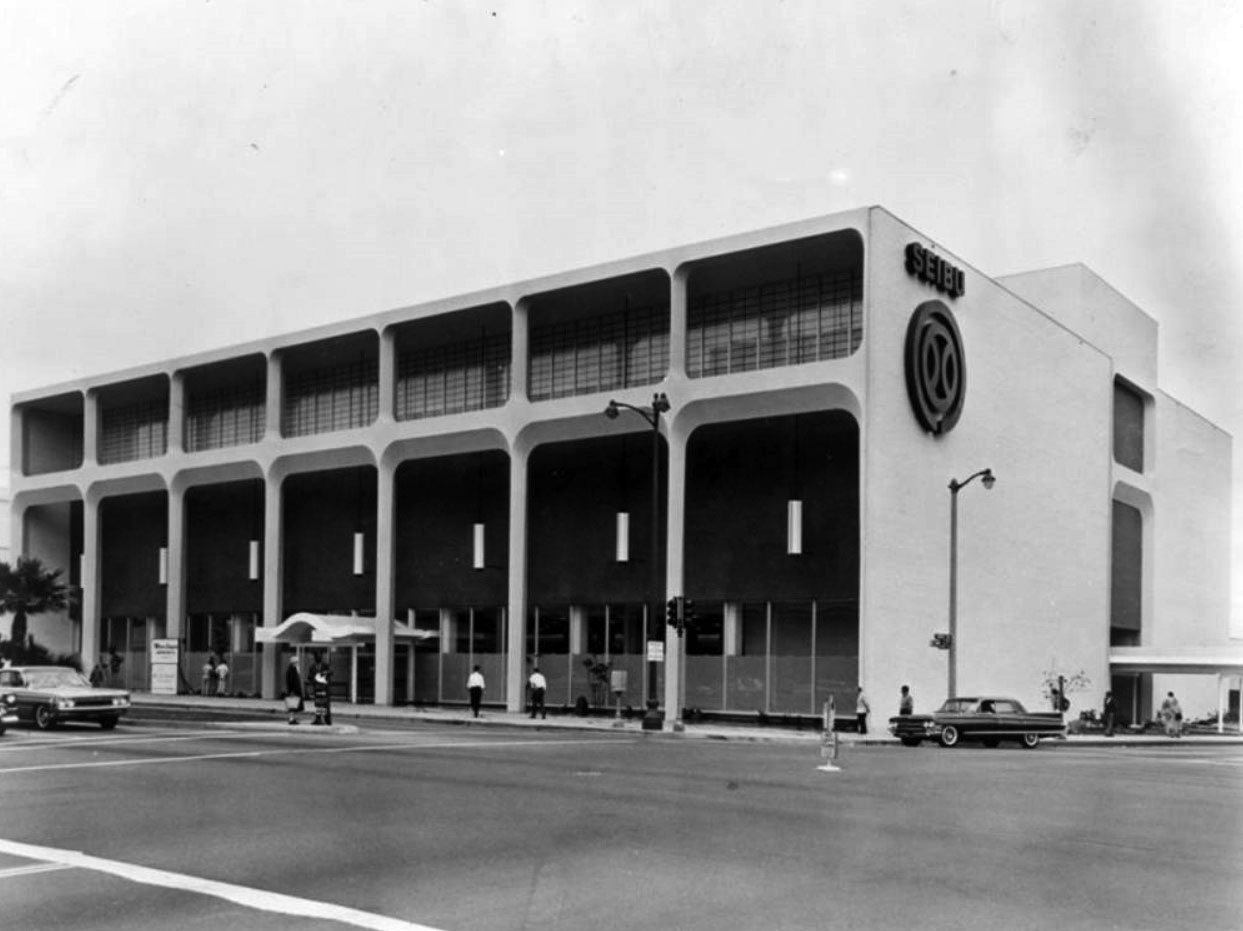 |
|
| (1962)* - Photograph caption reads, "New Japanese department store to open in Los Angeles. Seibu store features high-quality Japanese products." Located at 6060 Wilshire Boulevard (SE corner of Wilshire and Fairfax), the historic building was designed by Welton Becket and Associates. |
Historical Notes The Welton Becket and Associates building was originally built in 1962 for the U.S. branch of Japanese department chain store, Seibu. It was the first Japanese department store in the mainland United States. Despite much publicity, the store attracted little more than curiosity and closed after only two years. |
_1962.jpg) |
|
| (1962)* - Finishing touches to the gleaming facade of Los Angeles' newest department store, Seibu, are added as doors open for the first time on March 14, 1962. Across the street is May Co. Wilshire department store. The pair will be friendly competitors. |
Historical Notes This building was originally built in 1962 for the U.S. branch of Japanese department chain store, Seibu but closed after only two years. From 1964-1986, it operated as Ohrbach's department store. Many years later, Robert E. Petersen, founder of Hot Rod and Motor Trend magazines purchased the building, and along with his wife, Margie, founded the $40 million dollar Petersen Automotive Museum on June 11, 1994. The historic building, designed by Welton Becket and Associates, is located at 6060 Wilshire Boulevard. |
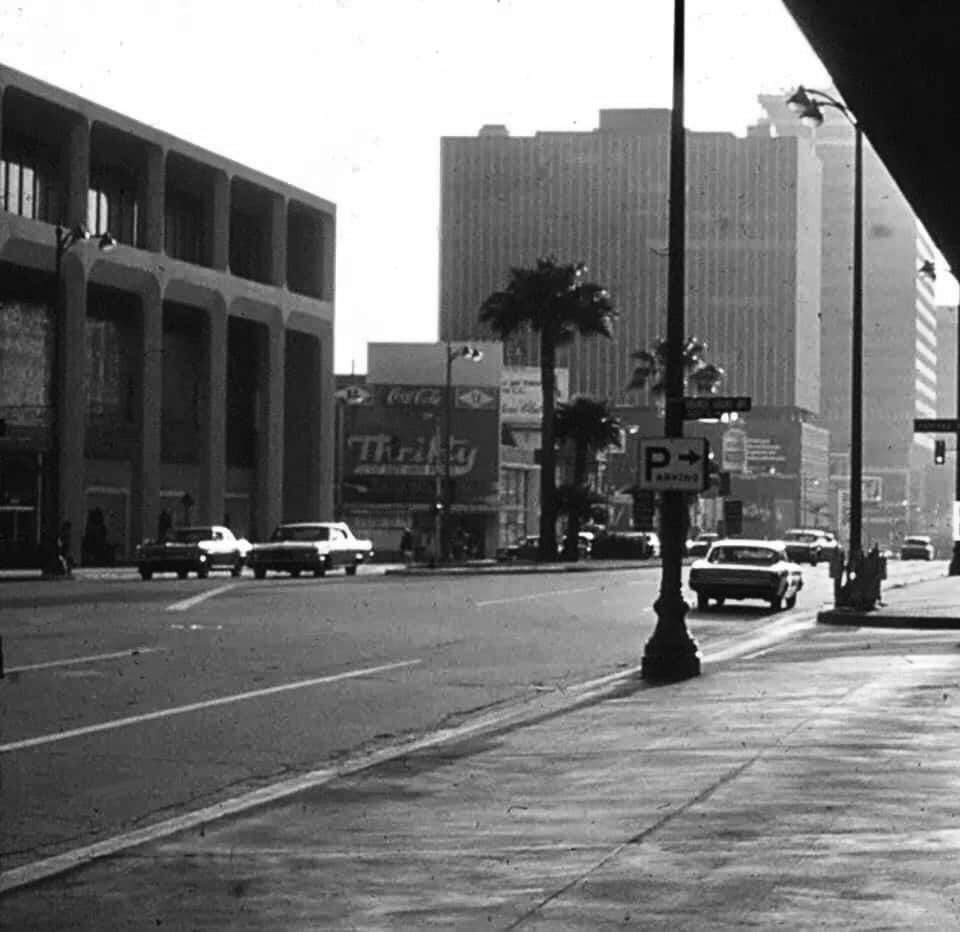 |
|
| (1971)* - View looking west on Wislhire toward Fairfax showing the Orbach’s Department Store in the Seibu Building with a Thrifty across the street on the SW corner. |
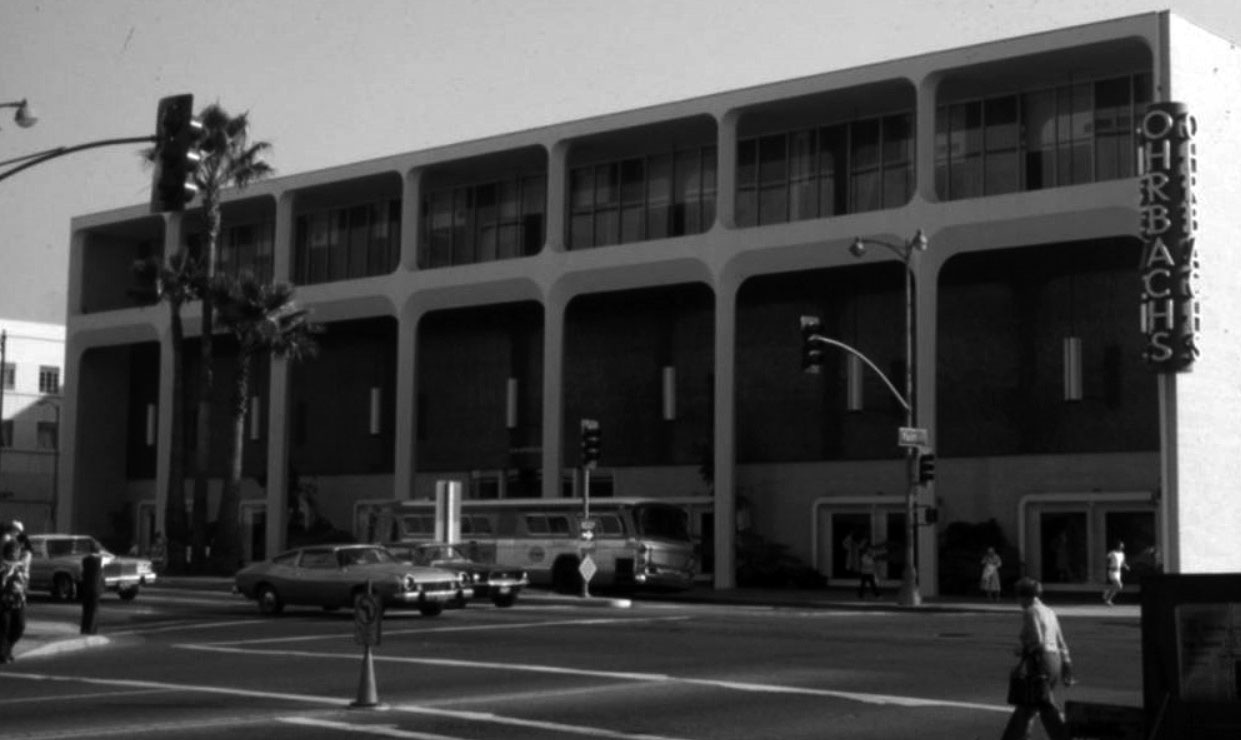 |
|
| (1978)* - Exterior view of Ohrbach's Department Store (previously Seibu), located at 6060 Wilshire Boulevard at Fairfax Avenue in Los Angeles. |
Historical Notes Ohrbach's was a moderate-priced department store with a merchandising focus primarily on clothing and accessories. From its modest start in 1923 until the chain's demise in 1987, Ohrbach's expanded dramatically after World War II, and opened numerous branch locations in the New York and Los Angeles metropolitan areas. Its original flagship store was located on Union Square in New York City, and they maintained home and administrative offices in Newark as well as in Los Angeles. The growth of the fashion industry in California encouraged the company's expansion to the state. The firm employed the services of a buying office in Los Angeles as early as 1939 and by 1945 opened its own. In 1948, it leased three floors and the mezzanine in a wing of the Welton Becket– William Wurdeman designed Prudential Insurance Company building on Wilshire Boulevard’s Miracle Mile. In 1965, the Miracle Mile store was relocated in the former Seibu Department Store at Wilshire and Fairfax Avenue. This is the current location of the Petersen Automotive Museum. |
 |
|
| (1970)* - View looking towards May Company from a northbound car on Fairfax Avenue at Wilshire Boulevard. On the right side is Ohrbachs Department Store, which opened in 1964 and closed in 1986. Photo Courtesy of Alison Martino, Vintage Los Angeles. |
Historical Notes Originally introduced by Ford in August 1968 as a package for the 1969 model year, the Mustang Mach 1 title adorned performance oriented Mustang offerings until the original retirement of the moniker in 1978, returning briefly in 2003 and 2004.^ Albert C Martin and SA Marx's 1939-40 May Company Wilshire was still bustling here, and by this time it even had its own gasoline station. Like most of the prominent stores on the Miracle Mile and the Wilshire District, the store's main entrance was in the rear, the easier to accomodate shoppers who parked their cars in the vast lots. In 1993 May Department Stores absorbed the venerable JW Robinson's chain, and so this store was shuttered in favor of the Beverly Hills Robinson's. Fortunately, it wasn't long afterward that the Los Angeles County Museum of Art annexed the building and took great care to preserve it. It is Los Angeles Historical-Cultural Monument No.566. In October 2011 the Academy of Motion Picture Arts and Sciences, in a joint project with LACMA, announced that the building would be the site for a new motion-picture museum. |
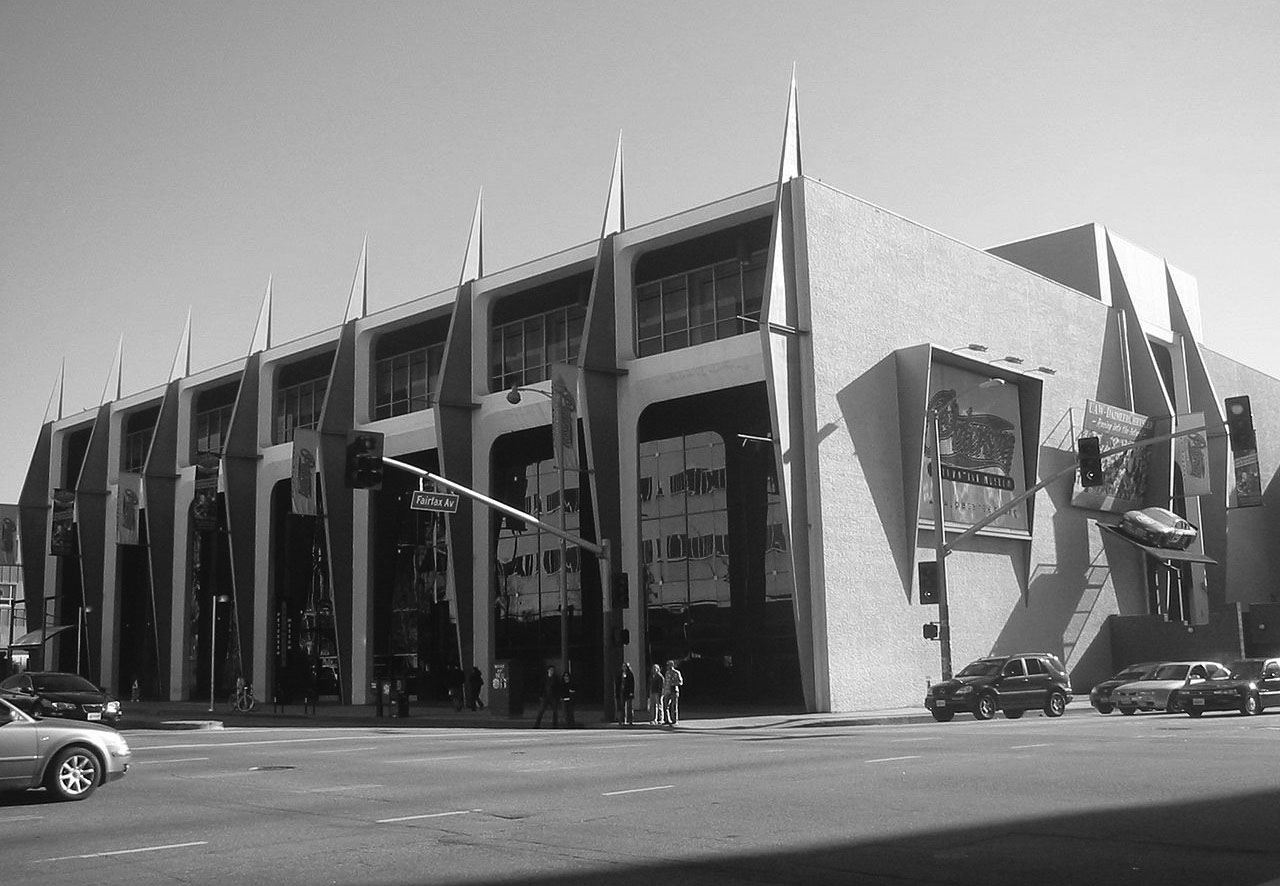 |
|
| (2006)* – View showing the Petersen Automotive Museum located in the original 1962-built Seibu Building. Photo by Gary Minnaert via Wikipedia |
Historical Notes Founded on June 11, 1994 by magazine publisher Robert E. Petersen and his wife Margie, the $40-million Petersen Automotive Museum is owned and operated by the Petersen Automotive Museum Foundation. The museum was originally located within the Natural History Museum of Los Angeles County, and later moved to a historic department store designed by Welton Becket. Opened in 1962, the building first served as a short-lived U.S. branch of Seibu Department Stores, before operating as an Ohrbach's department store from 1965 to 1986. Six years after Ohrbach's closed, Robert Petersen selected the largely windowless site as an ideal space for a museum—allowing artifacts to be displayed without harmful exposure to direct sunlight. |
Before and After
 |
|
.jpg) |
|
| (1962 vs. 2016) – Seibu Dept Store vs. Peterson Automotive Museum |
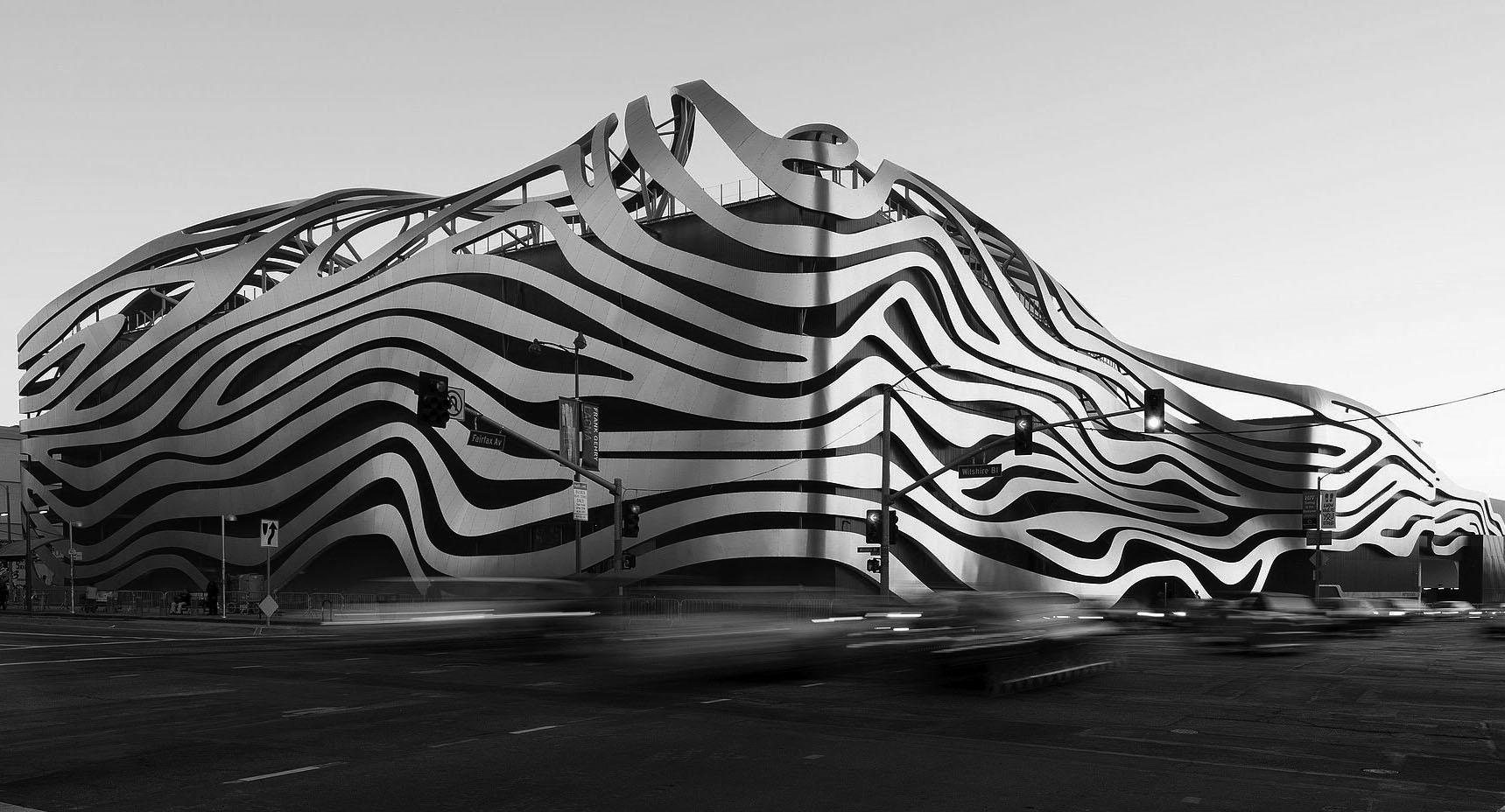 |
|
| (2015)* - View showing the Peterson Automotive Museum located on the SE corner of Fairfax and Wilshire after $125 million renovation. Photo by David Zaitz via Wikipedia |
Historical Notes In 2015, the Peterson Museum underwent an extensive $125 million renovation. The building's façade was redesigned by the architectural firm Kohn Pedersen Fox, and features a stainless-steel ribbon assembly made of 100 tons of 14-gauge type 304 steel in 308 sections, 25 supports and 140,000 custom stainless-steel screws. An Interpretive Master Plan, performed by ObjectIDEA and Brent Johnson Design, re-envisioned the exhibition program and re-organized the collection as three museum experiences under one roof: "The History, Industry, and Artistry of the Automobile." Designers at The Scenic Route configured interior spaces to accommodate changing exhibits. The remodeled museum opened to the public on December 7, 2015. |
 |
|
| (2019)* – View looking SW at Wilshire and Faifax showing the Peterson Automotive Museum and the 16-story 6100 Wilshire Blvd Office Bldg (aka The New Wilshire). Google Street View |
.jpg) |
|
| (ca. 2020)* – Looking down at the 6100 Wilshire Building from the roof of the Peterson Automotive Museum with Johnie’s Coffee Shop seen at lower-right. |
Historical Notes The 16-story 6100 Wilshire Boulevard Building (aka The New Wilshire) was built in 1986 and designed by William L. Pereira & Associates. William L. Pereira personally designed this tower. The wedge-shapped building features a facade of dark blue glass. Two sides of stainless steel balconies frame sliding glass doors in a combination designed to catch the light like cut crystal. |
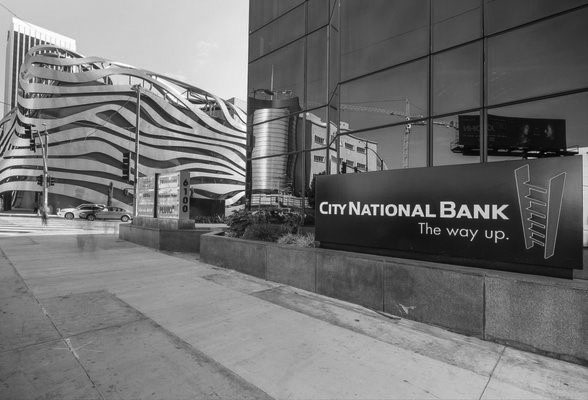 |
|
| (2019)* – View looking SW toward Wilshire and Fairfax showing the Peterson Automotive Museum across the street with the 16-story 6100 Wilshire Blvd Office Bldg (aka The New Wilshire) in the foreground at right. A City National Bank sign and also the reflection of the old May Co. Building is seen on the right. |
 |
|
| (ca. 2020)* – View looking East on Wilshire Boulevard toward Fairfax Avenue. All four buildings on the corners of the intersection can be seen: the old May Co. Building, Peterson Automotive Museum, 6100 Wilshire Blvd Building, and Johnie's Coffee Shop. The tall building in the distance is the 32-story SBE Entertainment Group Building, located across the street from the LA County Museum of Art. |
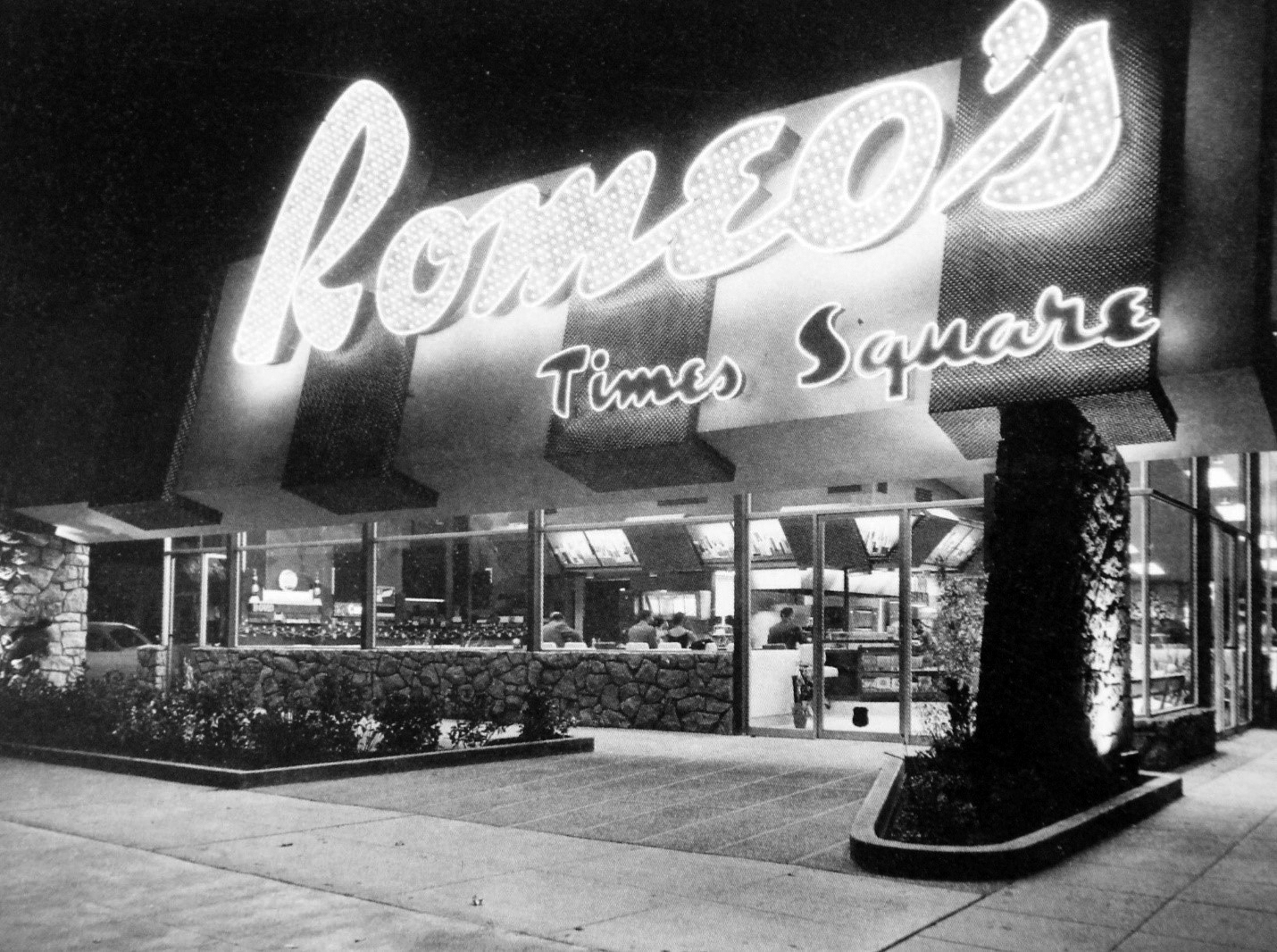 |
|
| (ca. 1956)* – View showing Romeo’s Times Square Coffee Shop (later Rams and then Johnie's Coffee Shop) located on the northwest corner of Wilshire Boulevard and Fairfax Avenue. The Googie-style coffee shop was built on the same site where Simon's Drive-in once stood. |
Historical Notes Romeo’s Times Square opened in 1956. It was in business only a few years, becoming Rams Coffee Shop in the early 1960s, and Johnie’s shortly thereafter. |
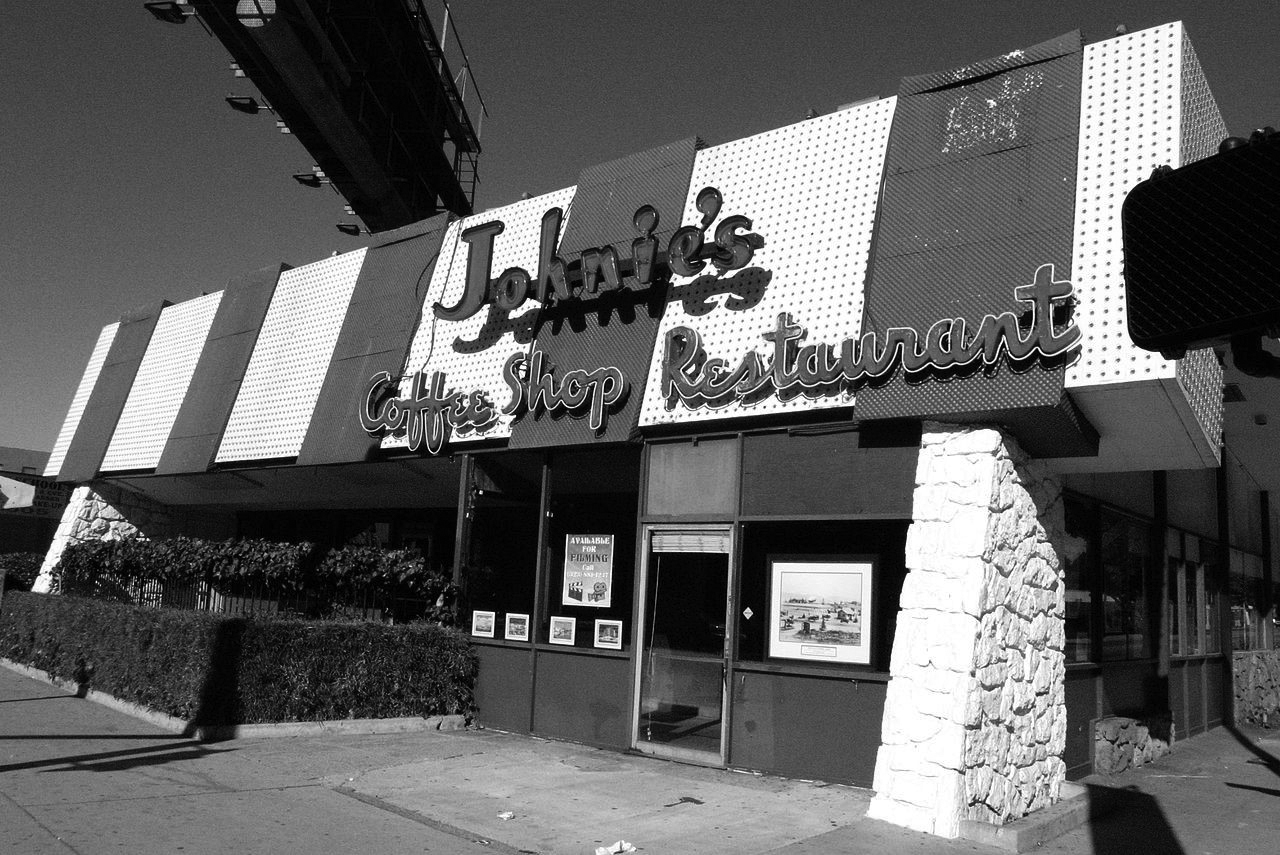 |
|
| (2007)* - Johnie's Coffee Shop Restaurant on Miracle Mile in Los Angeles, famous for being used as a location for many movies. Photo by Michael Mooney via Wikipedia |
Historical Notes Architects Louis Armét and Eldon Davis of Armét & Davis designed the building, contributing to their reputation as the premier designers of Space Age or Googie coffee shops—including the landmark Pann's Coffee Shop in Ladera Heights, Norms Restaurant on La Cienega Boulevard, and several Bob's Big Boy restaurants. The restaurant is perhaps best known as the setting for much of the first act of the 1988 cult film Miracle Mile, in which a patron learns that a nuclear war is about to begin. The restaurant also appeared in a 1999 Tom Petty and the Heartbreakers music video, "Swingin';" in a 2003 Reba McEntire music video, "Somebody;" and extensively in Sean Kingston's music video "Beautiful Girls." The restaurant is seen in several movies, including Volcano, starring Tommy Lee Jones; The Big Lebowski, starring Jeff Bridges and John Goodman; Reservoir Dogs starring Harvey Keitel and Tim Roth; and American History X, starring Edward Norton. Johnie's was also featured in the 2000 film Gone in 60 Seconds with Nicolas Cage. |
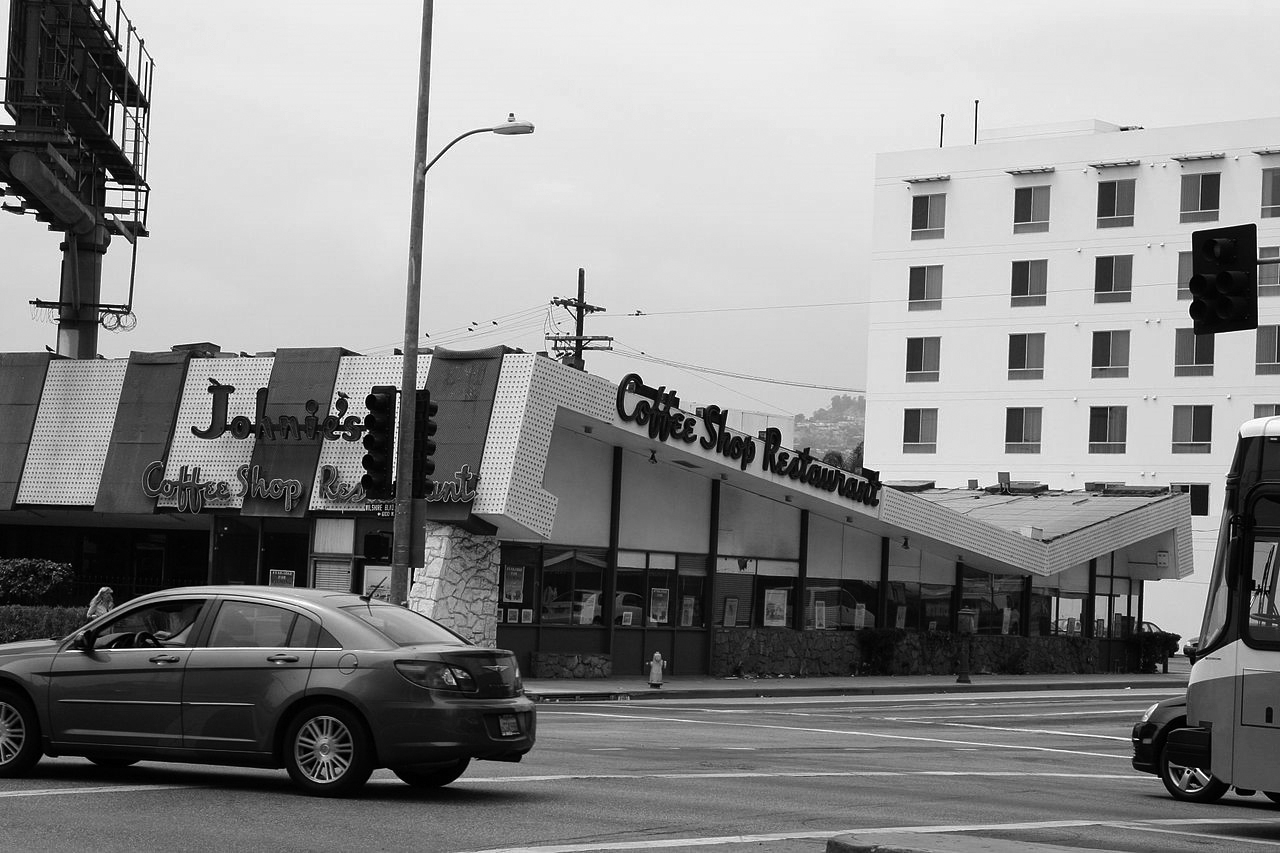 |
|
| (2009)* – View looking at Johnie's Coffee Shop with its Googie-style Architecture, located on the NW corner of Wilshire and Fairfax. Photo by ChildofMidnight via Wikipedia |
Historical Notes The restaurant was purchased in 1994 by the Gold family, founders of the 99 Cents Only Stores, and closed in 2000. The family leases the Johnie's parking lot to the Wilshire Boulevard 99 Cents Only outlet two doors away. Today, the largely intact interior acts as a backdrop for films and television shows. Johnie's was declared a historical landmark (No. 1045) by the Los Angeles City Council on November 27, 2013. |
 |
|
| (1980s)* - Johnies Coffee Shop and the May Company Building. - two iconic structures still standing at Fairfax and Wishire. Photo courtesy of Jeanie Lee |
Historical Notes The May Company Building was declared LA Historic-Monument No. 566 on September 30, 1992 |
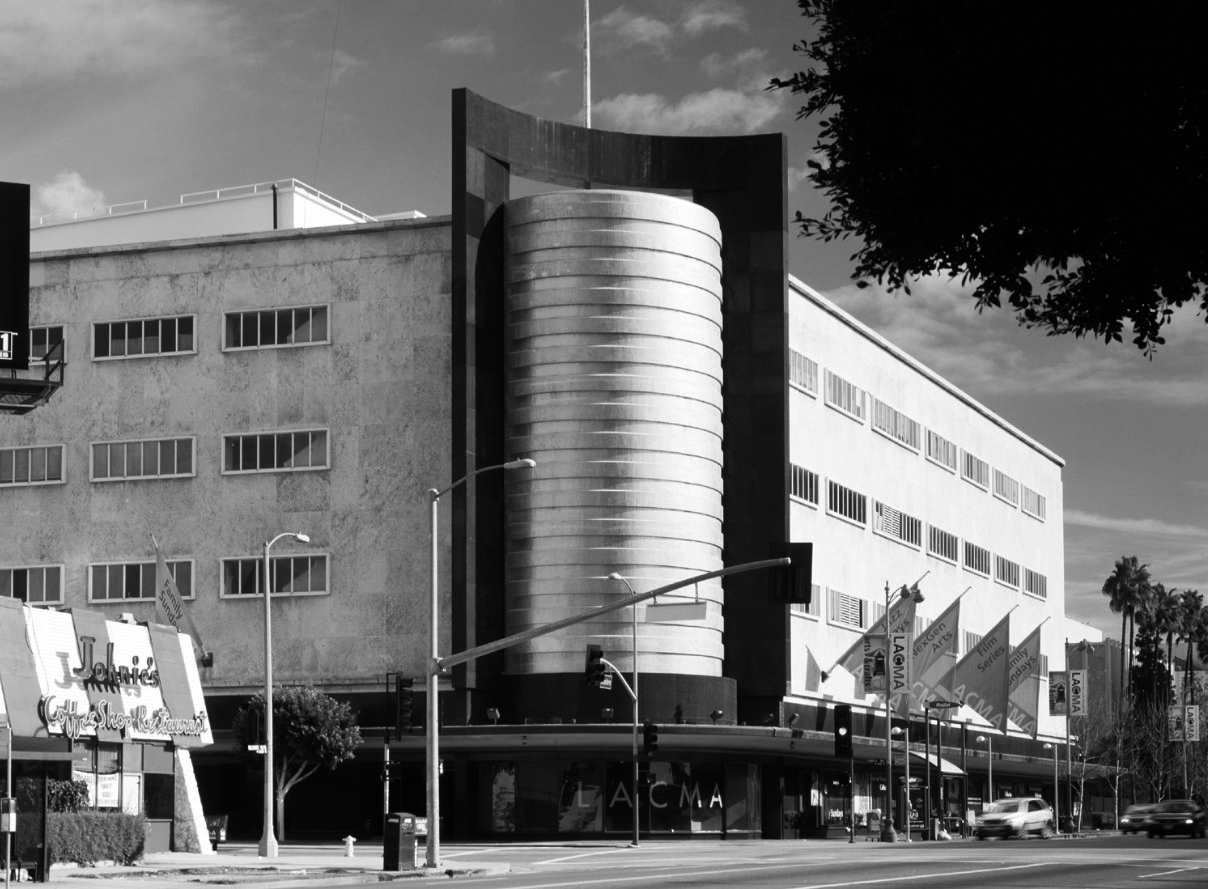 |
|
| (ca. 2010)* - May Company/LACMA West with Johnie's Coffee Shop across the street. Photo by Tim Street-Porter courtesy of the Academy Museum of Motion Pictures |
Historical Notes In 2018, the historic May Company Building, a Los Angeles Historic-Cultural Monument, was renamed the Saban Building in honor of a $50M gift from Cheryl and Haim Saban and is undergoing an extensive restoration and renovation to accommodate the Academy Museum of Motion Pictures. The May Company/LACMA West Building/Saban Building is scheduled to be repurposed by 2020, at which time The Academy Museum of Motion Pictures is planning to move in. |
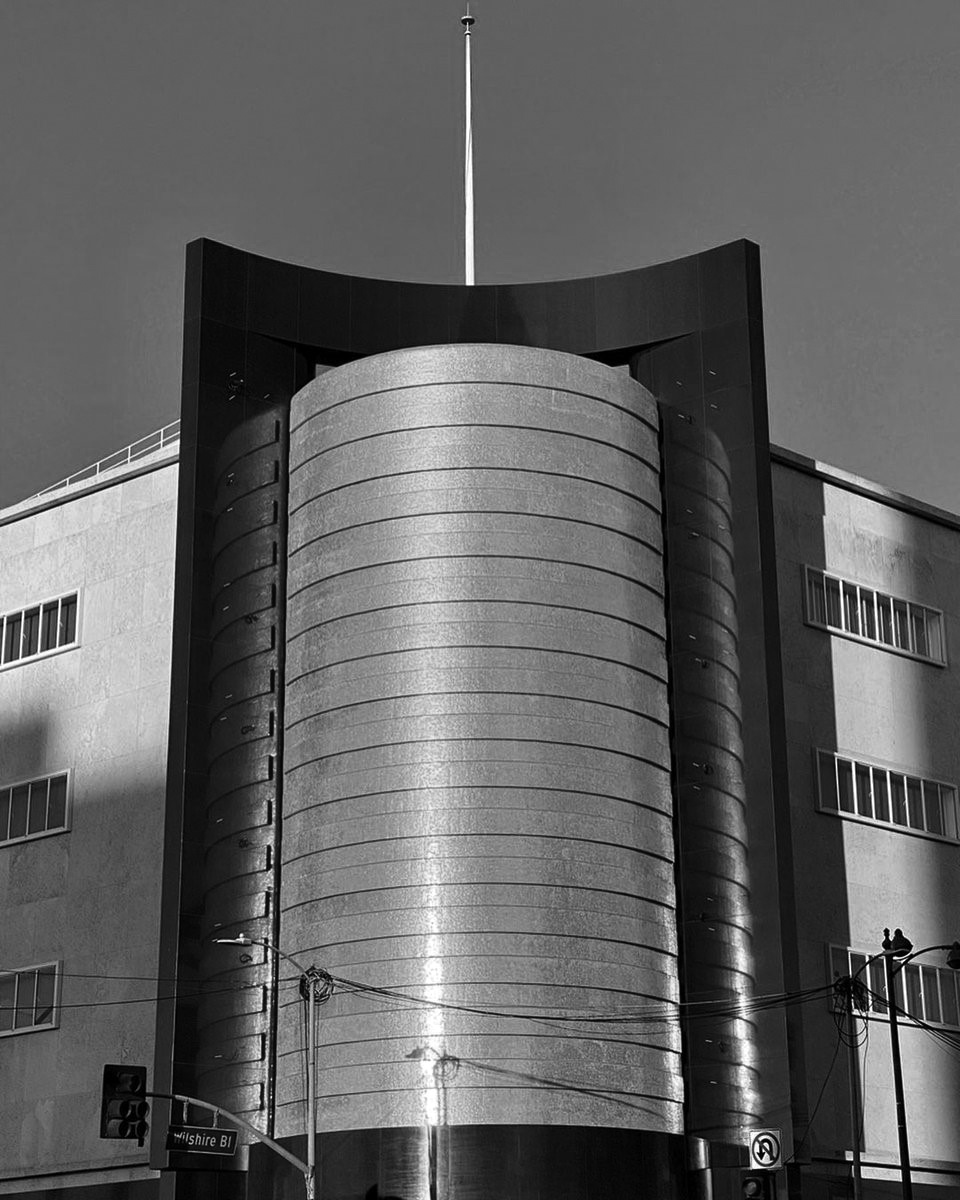 |
|
| (2020)* - The May Company/LACMA West Building (aka Saban Building) being repurposed to become the Academy Museum of Motion Pictures. Photo courtesy of the Academy Museum of Motion Pictures |
Historical Notes The Academy of Motion Picture Arts and Sciences signed a long-term lease with LACMA and is converting the former original department store building into a museum dedicated to motion pictures. The rear addition (Albert C. Martin, 1946) will be demolished to make way for a 140-foot-diameter spherical addition of glass and steel. The project architects are Renzo Piano and Zoltan Pali. |
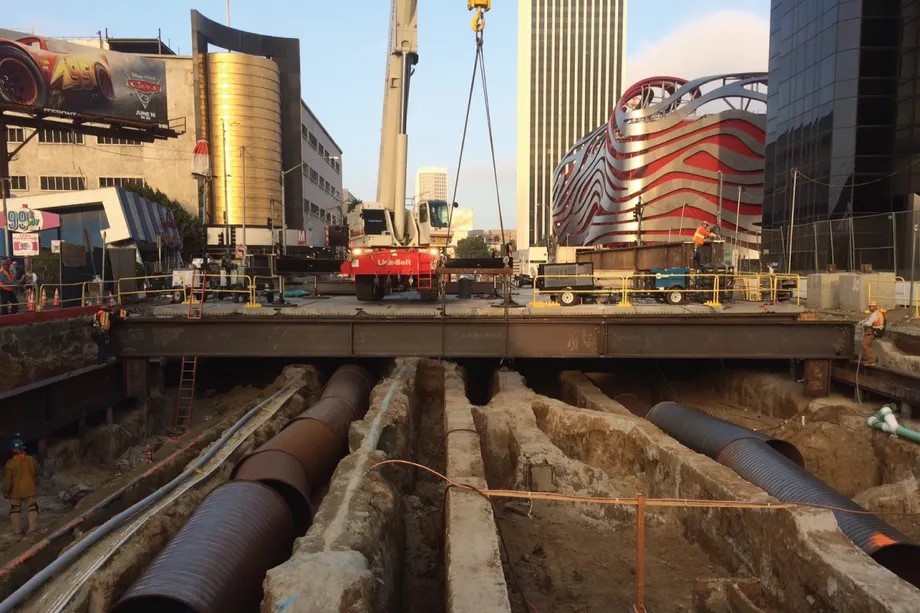 |
|
| (2021)* - Purple Line construction looking East on Wilshire toward Fairfax. Photo courtesy of Metro. |
Historical Notes The Los Angeles Metro D Line Extension Project, formerly known as the Purple Line Extension, is a heavy rail subway expansion extending the D Line from Wilshire/Western in Koreatown to the Westside region. The project, overseen by the Los Angeles County Metropolitan Transportation Authority (Metro), is being constructed in three sections. Section 1, which includes the Wilshire/La Brea, Wilshire/Fairfax, and Wilshire/La Cienega stations, began construction in 2014 and is expected to open in 2025. Section 2 extends the line to Century City, with completion slated for 2026, while Section 3 reaches Westwood and is anticipated to open in 2027. Metro has designated the project as a high priority in its long-range plans, with funding secured through voter-approved sales tax measures, Measure R (2008) and Measure M (2016), supplemented by federal funds covering approximately half the total cost. For the Wilshire/Fairfax Station, a station entrance is planned at the southeast corner of Wilshire Boulevard and Orange Grove Avenue. Metro is also in discussions with the Los Angeles County Museum of Art (LACMA) about funding a second entrance, which would help reduce pedestrian crossings at street level while maintaining bus connections. |
Click HERE to see Earlier Views of the Miracle Mile (1920s & 1930s). |
Click HERE to see more Early Views of the Miracle Mile (1940s & 1950s). |
* * * * * |
Please Support Our Cause Water and Power Associates, Inc. is a non-profit, public service organization dedicated to preserving historical records and photos. Your generosity allows us to continue to disseminate knowledge of the rich and diverse multicultural history of the greater Los Angeles area; to serve as a resource of historical information; and to assist in the preservation of the city's historic records. |
For more Historical Los Angeles Views click one of the following:
For Other Historical Views click one of the following:
See Our Newest Sections:
To see how Water and Electricity shaped the history of Los Angeles click one of the following:
Water:
Power:
* * * * * |
References and Credits
* DWP - LA Public Library Image Archive
^ LA Public Library Image Archive
*^Oviatt Library Digital Archives
^^LA Times: Photo Archive; An Oil Well on La Cienega; Mulholland Bridge; A Mountain of Red Cars; The Vincent Thomas Bridge; Hill Street Tunnels; Harbor-Santa Monica Freeway Interchange; Dodgers Caravan,1958
#*MTA Transportation and Research Library Archives
+#Facebook.com: Garden of Allah Novels
#^^Picturetrail.com: KCET - Angels Flight
#^*Downtown LA Public Art: Fort Moore Pioneer Monument
^**Flickr: Enock 1; Eric Richardson
*^#Los Angeles Conservancy: LA Stock Exchange Building; Park La Brea
^#^Pacific Electric Railway Historical Society - Alan Weeks Collection
*#*Westland.net: Venice History
*#^Forum.Skyscraper.com: Arroyo Seco Library; Westwood-Life Magazine; North Los Angeles Street
^#*Metro.net: Mulholland Drive Bridge
**#The California History Room, California State Library: William Reagh
#**Pinterest - California and DailyBreeze.com
#^#Deadhistoryproject.com: Silent Movie Theater
+**Los Angeles' Bunker Hill - Alta Visa Apartments
+##MartinTurnbull.com: Fairfax and Wilshire
^^+How Stuff Works: Chevrolet Impala
+#+Pinterest - California and DailyBreeze.com; Mid Century Hollywood
++#Facebook.com: Photos of Los Angeles
^^#The George A. Eslinger Street Lighting Photo Gallery
^^*Early Downtown Los Angeles - Cory Stargel, Sarah Stargel
***Los Angeles Historic - Cultural Monuments Listing
*^*California Historical Landmarks Listing (Los Angeles)
*^^Nuestra Señora la Reina de los Ángeles: losangelespast.com
**** Pinterest.com: Los Angeles Dodgers; Los Angeles and Hollywood; MacArthur Park w/Downtown Skyline; Gilmore Self-Service Gas Station
**^*California State Library Image Archive
**^#Vintage Los Angeles: Facebook.com - Gilmore Stadium and Field; Cruising Hollywood Blvd
^^^^Depaul.edu: Night Train 55
**#^Vincent Thomas Bridge - Facts and Figures
*#**Flickr-Los Angeles in Good Light - Ron Reiring
^#^^Flickr.com: Michael Ryerson
*#^#Life.time.com: Stoked-Life Goes Surfing
^#^#Pinterest: Bygone Los Angeles
*#*#Abandoned & Little-Known Airfields – Paul Freeman
^#*#LA Magazine: Beverly Park Ponyland
^^##Pacific Electric Railway Historical Society
^^*#Historic LA Theatres: Downtown Broadway Theatres
^^#*LA Observed.com: Decommissioned Street Cars; Bunker HIll, 1964
*^^*Pinterest.com: Bertrand Lacheze
^^**Pinterest.com: Vintage California
^^++Huntington Digital Library Archive
*##*Pinterest.com: Trucks, Pick-Ups, and Gas Stations
*##^LAist.com: Harbor Freeway, 1969; Century Plaza Hotel
##*^Port of Los Angeles: portoflosangeles.corg
##^*Calisphere: University of California Image Archive
##^^Cinema Treasures: Olympic Drive-In
#**#California State University Northridge History: csun.edu
#++#The Pacific Electric Railway Historical Society (PERyHS)
#*##Daily News: Mulholland Bridge
#^**The Go Go's: N/W Corner of Hollywood and Vine
#^*#Flickr.com: Paul Bajerczak
##^#Facebook.com: Classic Hollywood-Los Angeles-SFV
^***UCLA Library Digital Archive
^^^*KCET: Welcome to L.A. River; Four Level Interchange; Construction of 5 Southern California Freeways; Beverly Park and Ponyland; Before the 'Carmageddon': A Photographic Look at the Construction of 5 SoCal Freeways; Seventh and Broadway; L.A.'s First Freeways
****^Facebook.com: West San Fernando Valley Then And Now
*^^^^Los Angeles Maritime Museum
^^^**tumblr.com: John Ferraro Office Building; DWP Office Building
**^^^Facebook.com - San Pedro's Original Website, San Pedro.com
#*#**Facebook.com: Beverly Park - L.A.'s Kiddieland
**#**LMU Digital Archive
**^ Noirish Los Angeles - forum.skyscraperpage.com; Westwood-Life Magazine; Selling Papers on Olive; California Federal Plaza Building; Downtown Aerial 1958; 1949 Construction of 101 Freeway; 1953 Harbor Freeway Construction; Wilshire Blvd, 1949; Zephyr Room and Brown Derby Postcard View; Aliso Before and After 101 Frwy; Vincent Thomas Bridge; Gilmore Aerial; Hollywood Frwy Traffic Jam; 2012 Downtown Skyline; View from GOB; Bonaventure Hotel Aerial; Hollywood and Vine
^* Wikipedia: Hollywood Sign; Carthay Circle Theatre; Fairfax High School; Park La Brea; San Vicente Boulevard; Etymologies of place names in Los Angeles; Los Angeles Central Library; Broadway Tunnel; Pershing Square; Pacific Electric Railway; Gilmore Field; GilmoreStadium; Union Station; Westwood; 6th Street Viaduct Bridge; Figueroa Street Tunnels; Chavez Ravine; 2nd Street Tunnel; Hollywood Freeway; Los Angeles International Airport; Los Angeles City Hall; Wilshire Boulevard Temple; Egyptian Theatre; The Pig 'N Whistle; Sunland-Tujunga; Van de Kamp Bakery Building; Los Angeles County Art Museum; Los Angeles City Oil Field; Los Angeles Railway; Miracle Mile; Interstate 405; Chevrolet Impala; Playa Vista; Harbor Frwy (Interstate 110); History of Los Angeles Population Growth; Los Angeles City Hall Lindbergh Beacon; May Company California; Four Level Interchange; California Federal Bank; Harbor Freeway; Arroyo Seco Parkway; Brown Derby; 2004 Los Angeles Skyline; LA's Oldest Palm Trees; Vincent Thomas Bridge; World Cruise Center; CSUN; Westwood; Westwood Village; UCLA; History of UCLA; 1950s Americal Automotove Culture; Pershing Square; Century Plaza Hotel; California Incline
< Back
Menu
- Home
- Mission
- Museum
- Major Efforts
- Recent Newsletters
- Historical Op Ed Pieces
- Board Officers and Directors
- Mulholland/McCarthy Service Awards
- Positions on Owens Valley and the City of Los Angeles Issues
- Legislative Positions on
Water Issues
- Legislative Positions on
Energy Issues
- Membership
- Contact Us
- Search Index